There’s less than a month to go until Expo 2025 comes to an end. Osaka.com has already covered most of the basics with our detailed guide that was published in March. This article reflects my personal experiences visiting Expo 2025 on a single day and is not meant to be a guide for reference. By this point most people have made up their minds about attending the event, but if you are planning to go, I hope there is some information here that can help make your visit a more enjoyable experience. Without further adieu, let’s jump right in.

Table of Contents
10:40 Boarding The Bus
We drove to the designated parking lot in Maishima and boarded a shuttle bus at 10:40 The fare was part of the admission package, which was saved on my wife’s phone. Before setting out, we purchased about four bottles of water at a local supermarket because we knew that prices would be high once we got inside. It took exactly 15 minutes to arrive at Yumeshima, the site of the Expo.

10:55 Arrival at Expo 2025
We managed to get seats without any problems, and enjoyed the short ride to the entrance Expo Grounds. We had expected to wait a long time, but it was less crowded than expected. A friend of ours who went on the same day told us that the entrance closest to the train station was packed and there was a long wait to get in.

11:00 Going through Security
Going through security was a breeze and certainly much quicker than going through the airport. Of of the workers, an older gentleman asked me to open my bag and tried to explain in English that PET bottles had to be carried in separately. He struggled to get the meaning across, but I appreciated his effort. It’s important to remember that even though this is a major international event, not all of the workers on the premises are proficient in a foreign language.

11:00 Entering the grounds
My wife had made reservations for the Kuwait and Australian Pavilions but we had a couple of hours before our first reservation so we decided to walk around and visit some of the less crowded pavilions that did not require a reservation. We came to a statue of Myaku Myaku, the official mascot of Expo 2025. The smiling red globe next to it is the YOSHIMOTO Pavilion Waraii Myraii where comedy shows are held. Osaka is famous for comedy and Yoshimoto has produced many of the top stars in Japan.
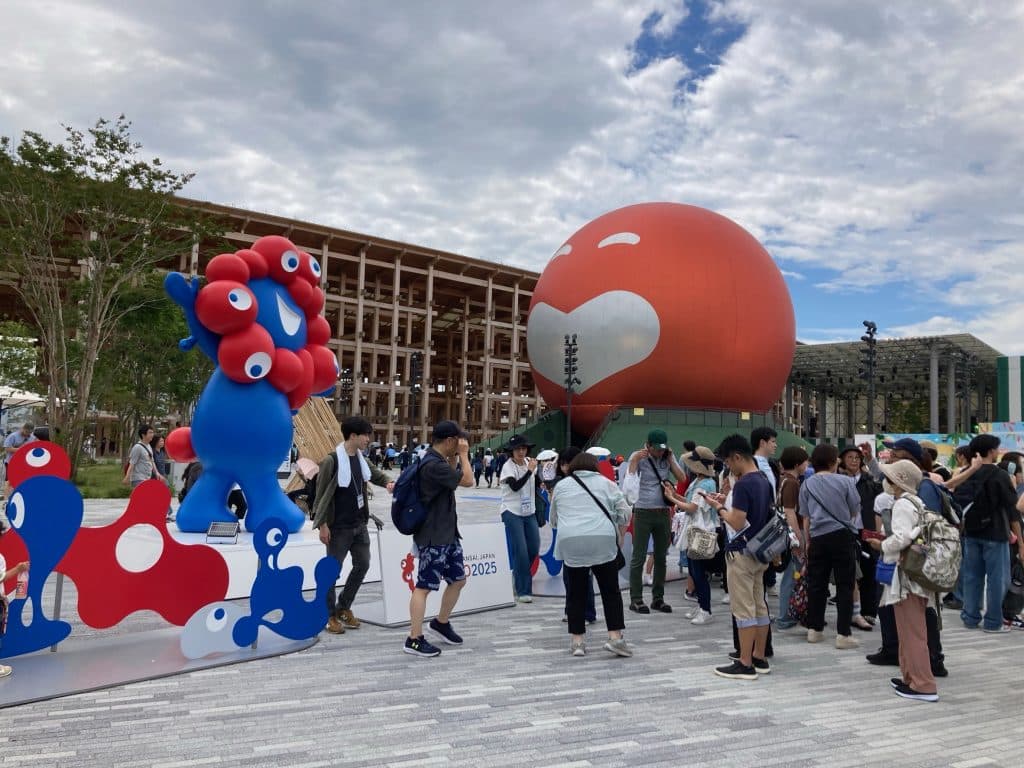
HIWADROME
The next sculpture I saw was one of the most impressive things at Expo 2025. The piece is titled HIWADROME and it’s made up of 75 wheelchairs, all painted white. The artist who designed the sculpture, Hiwa Kazuhiko uses a wheelchair, and the mirrors attached to the installation are there so that visitors can see themselves in relation to the work. Reportedly, the artist was influenced by Jackson Pollock’s all-over painting technique that fills space in a way that blurs center versus periphery.
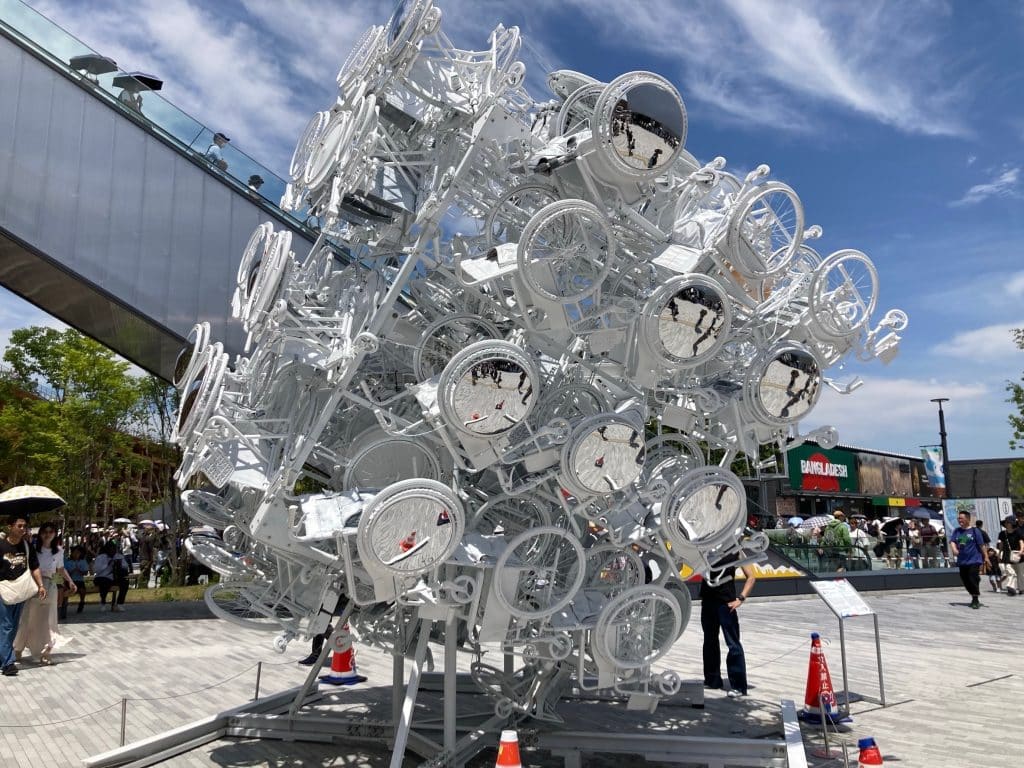
The sculpture was located close to the Belgium Pavilion which already had a long line. I had heard that this popular pavilion is a “must-visit” but it soon became apparent that there was no way we would be able to make it in today without a reservation.
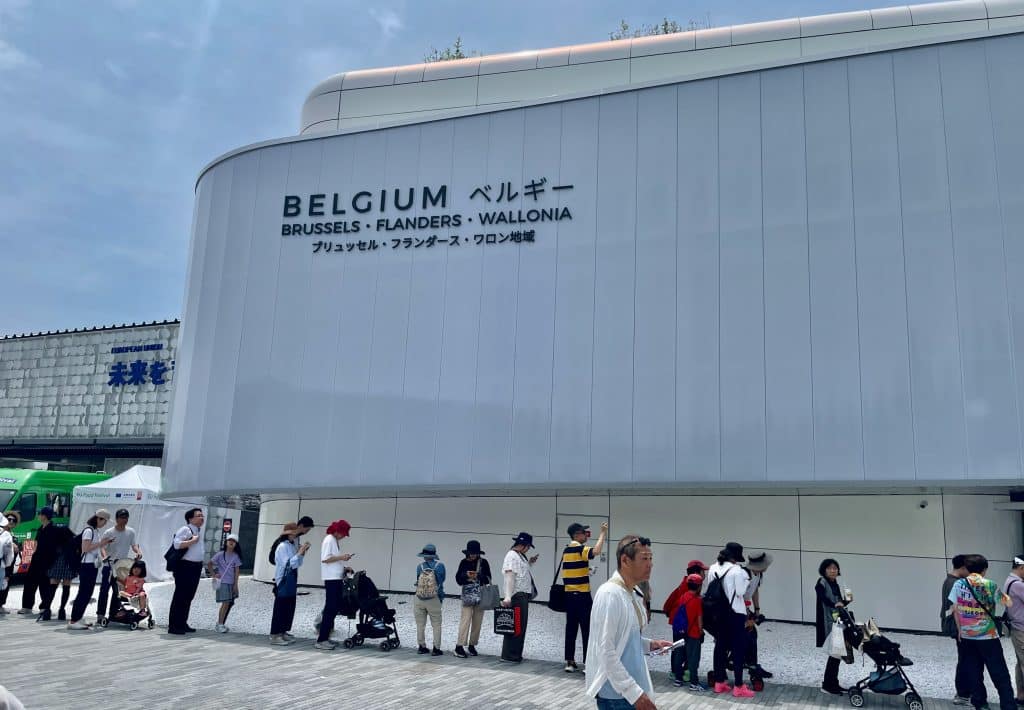
Gundam Next Future Pavilion
I am not a Gundam fan per say, but I have a basic understanding the cultural impact the series has had both inside and outside Japan since the premiere of the anime series Mobile Suit Gundam in 1979 that depicted giant robots in a militaristic setting. After seeing the impressive 12.3 meter Gundam statue outside, I really wanted to see the exhibit, which I was informed lasts 50 minutes. Unfortunately, all reservations were booked until 2PM. After that time, you can sign up for on-site registration.
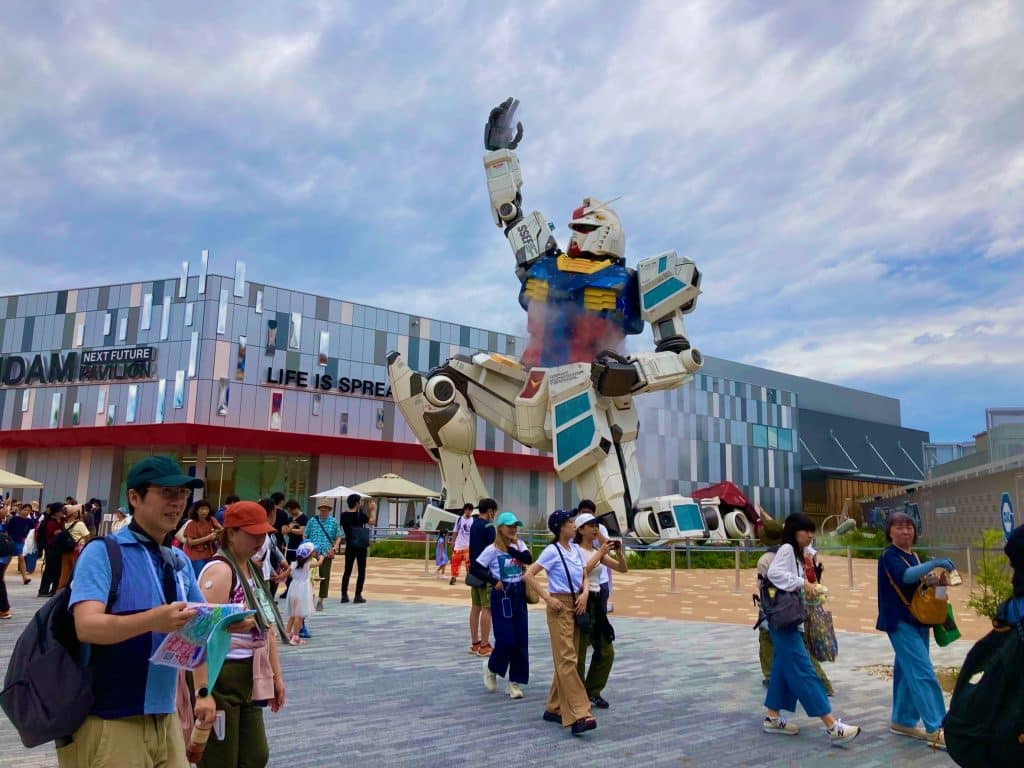
11:15 Cambodian Pavilion
I have an interest in Cambodia, so I was happy to see that there was almost no line to get into the next pavilion. This was one of the better pavilions I visited because there were many cultural artifacts to see, instead of the many digital screens and laminated posters spouting information that one could easily find on Wikipedia. The pavilions architecture was inspired by Koh Ker, “a remote World Heritage site in Northern Cambodia that served as the capital of the Khmer Empire from 928-944”
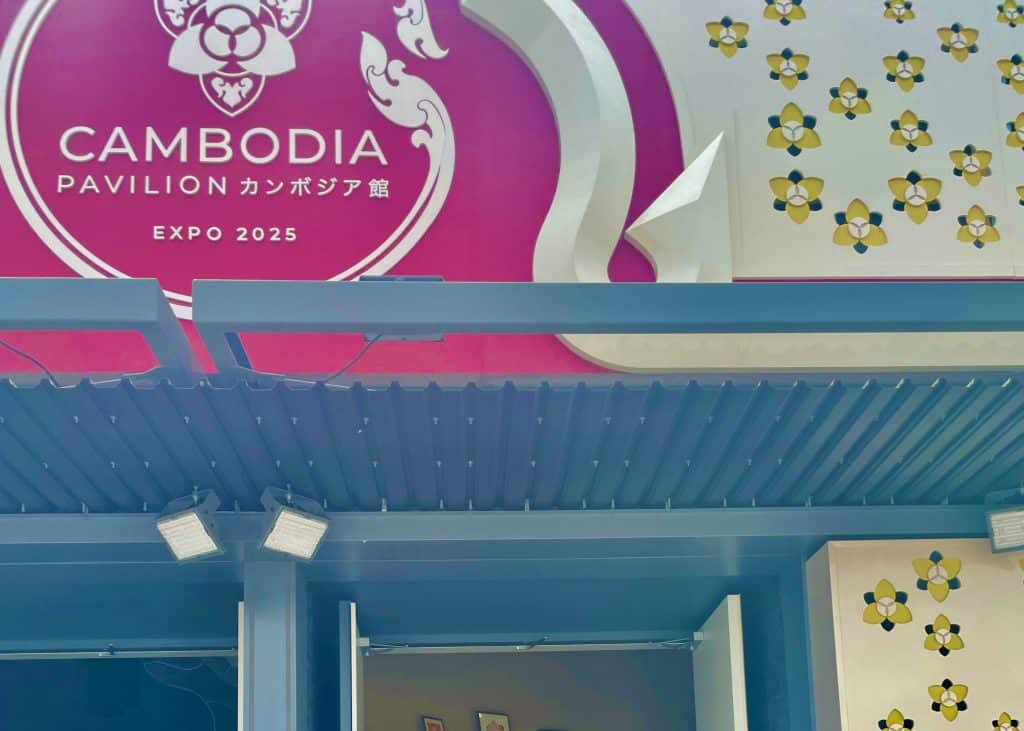
Lord Vishnu
The first thing that caught my eye when I entered was a wooden statue of the Hindu Deity Lord Vishnu. According to the Pavilions official website: “It took 500 hours for our artisans to carve this piece in wood, 144 hours for plastering, and 40 hours for the polychrome process and gilding.” I was surprised to see this because I know Cambodia as a Buddhist majority nation. I learn that Hinduism took root among the Khmer ruling elite in the fourth century and eventually became the dominant religion over time. Today there are only around 1,000-15,000 people who still practice Hinduism.
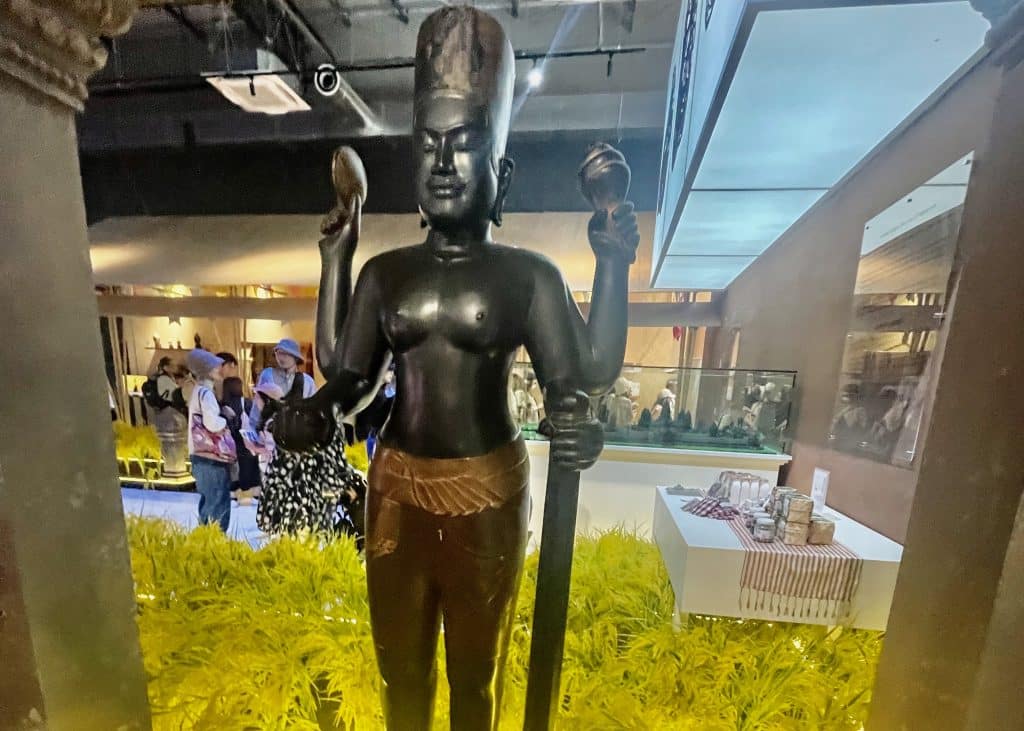
Fishing with a Net
If you look carefully in the background, you can see an impressive bas relief sculpture of Angor Watt. Unfortunately it was covered in glass and I couldn’t get a good photo. In a section on fishing in Cambodia I spotted a simple, but wonderful sculpture of a fisherman standing in a small wooden boat casting a net. I wanted to know more about the artist and how it was made, but didn’t notice the card below with a written explanation of the details.
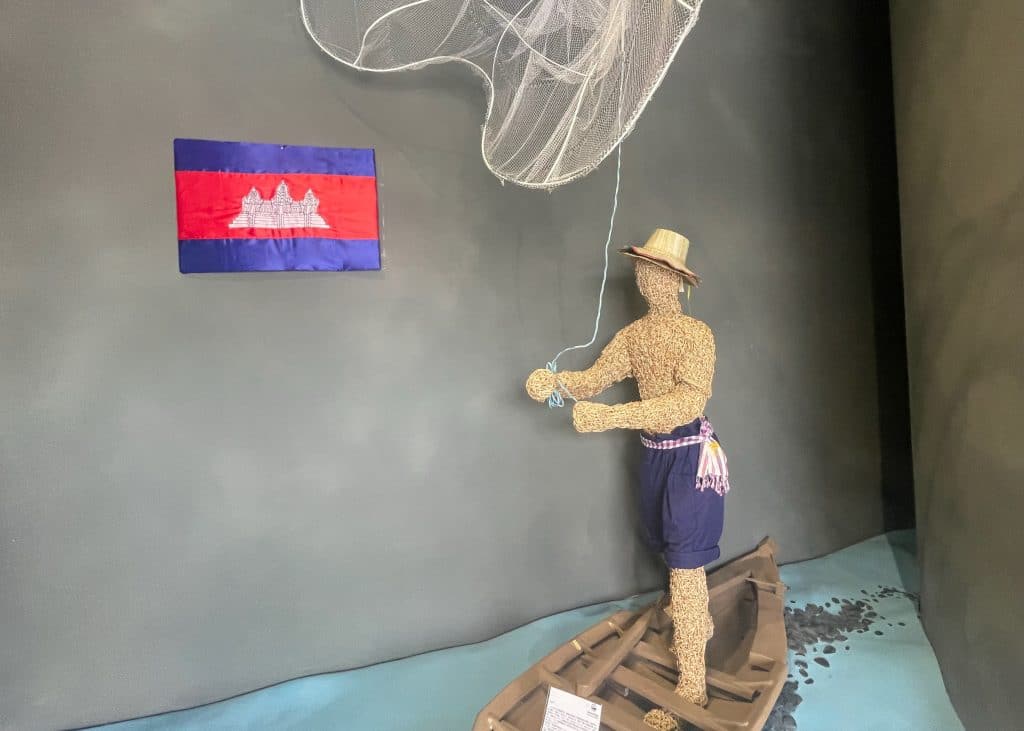
Majestic Ruins
The Cambodia Pavilion has received attention on social media for a stunning (replica?) of the ruins of a temple. This was like bringing a cultural heritage overseas one brick at a time. Even though it was most likely assembled in Japan, it felt like being in Cambodia for a fleeting moment. Once again, kudos to the staff who planned this for creating a tangible experience that did not rely on flashy digital graphics or artificial intelligence.

11:30 Bangladesh Pavilion
I honestly did not spend a lot of time here, because we had to get to the next place, so think of this as just a brief pop-in. The Pavilion aimed to bridge Bangladesh’s cultural heritage with its modern innovations. I enjoyed the traditional crafts and handiwork, especially the hand-embroidered quilts called Nakshi Kantha displayed at the entrance.
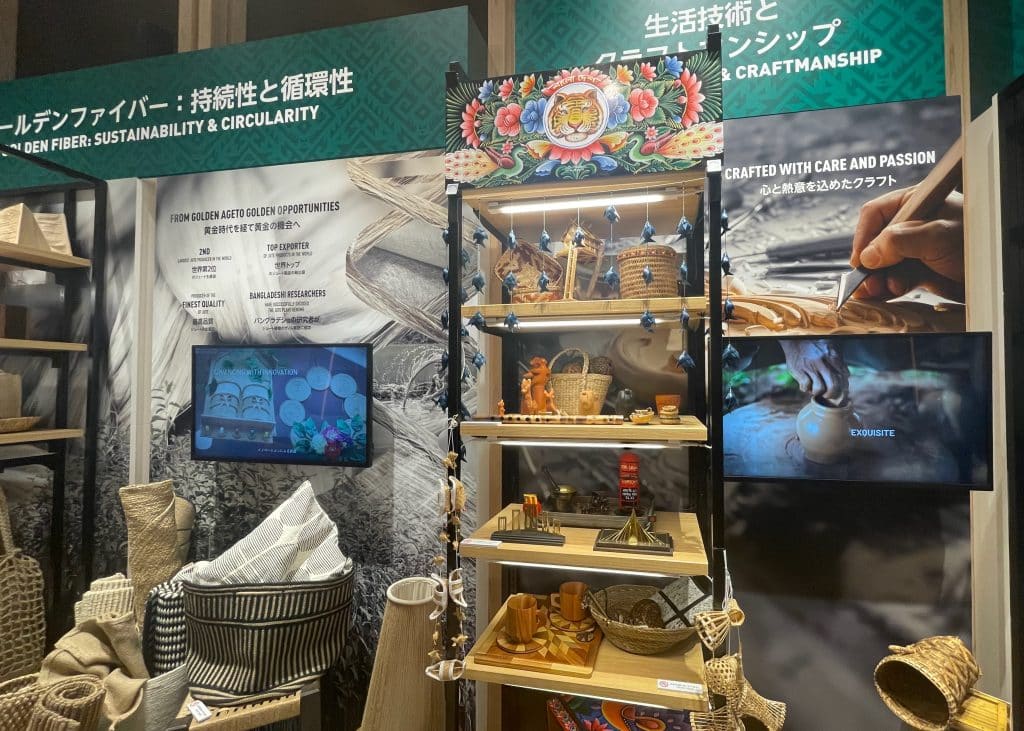
A World Expo is a place where countries present their best side to the rest of the world, so its very rare to see any controversial or negative displays relating to recent history. That’s why I was very surprised to see a wall devoted to graffiti art from the 2024 “July Revolution” that has been described as the first “Gen Z” revolution. I’m not going to pretend that I know anything about Bangladeshi politics, I just thought it was a nice touch that the government allowed these student protesters to have their views represented to the entire world.
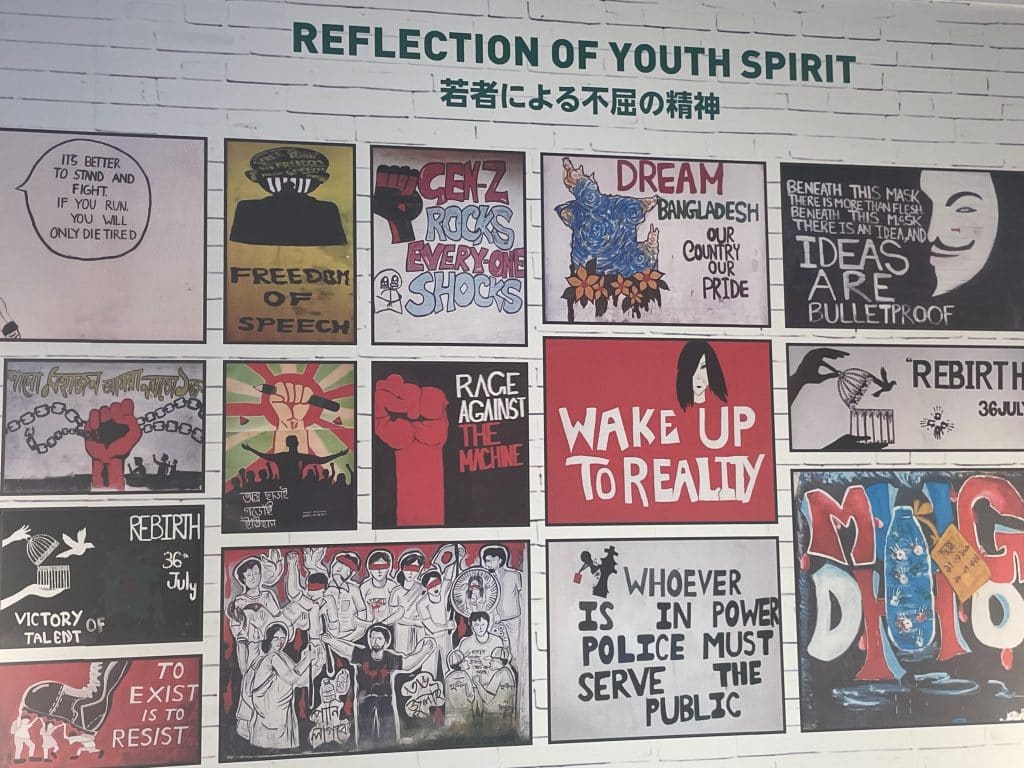
11:55 Singapore Pavilion
As I mentioned earlier, my wife booked reservations to the Australia and Kuwait Pavilions, but for some reason, they did not go through. Although we were disappointed, we decided to make the best of it. We noticed that the line to the Singapore Pavilion seemed to be progressing rapidly, so we hopped in line. The main structure is a 17 meter “Dream Sphere” clad in thousands of red discs made of recycled material.

One of the first exhibits inside the sphere is called “City in Nature,” which is meant to highlight a tree planting campaign that began 60 years ago as a greening effort. The “trees” are actually delicate paper-cut / paper-sculpture art installations by artists Melissa Tan and Ashley Yeo. I marveled at the intricate designs, all carefully crafted by hand.
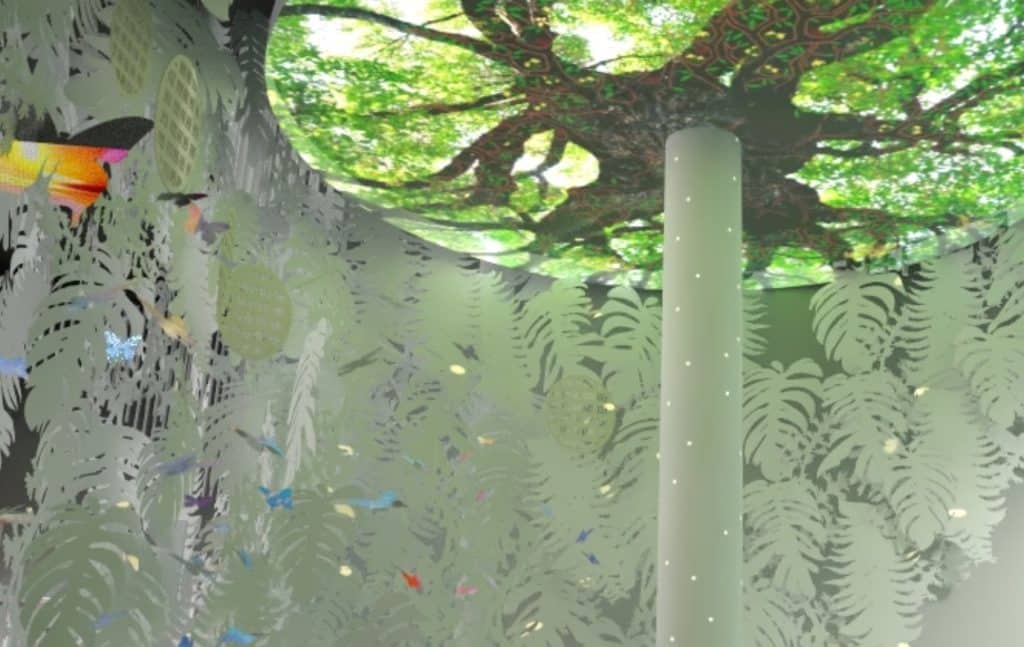
Another stand-out exhibit was the “Forest of Light / City of Spheres installation. The glowing orbs and spheres represent seeds, planets or life cells. Visitors can touch and interact with some of the spheres, which causes light and color changes. I really didn’t understand what I was doing, but the majority of the other visitors seemed mesmerized with this interactive part of the exhibit.
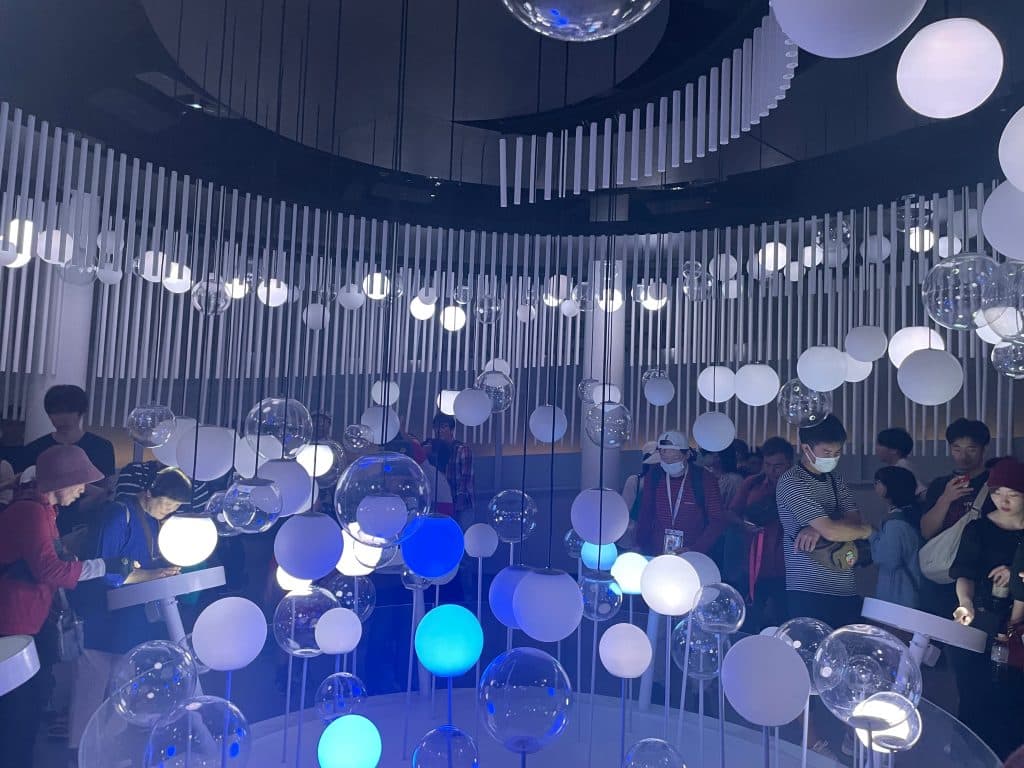
12:40 Commons D
Most countries participating in Expo 2025 don’t have the luxury of their own buildings. Instead, they are housed in booths or rooms within five larger structures called Commons. Commons B hosts the largest number of countries, with 26 nations exhibiting, while the smallest, Commons F, features only three. (For some reason, there is no Commons E.) Regardless of their size, all of these exhibitions are referred to as “pavilions.”

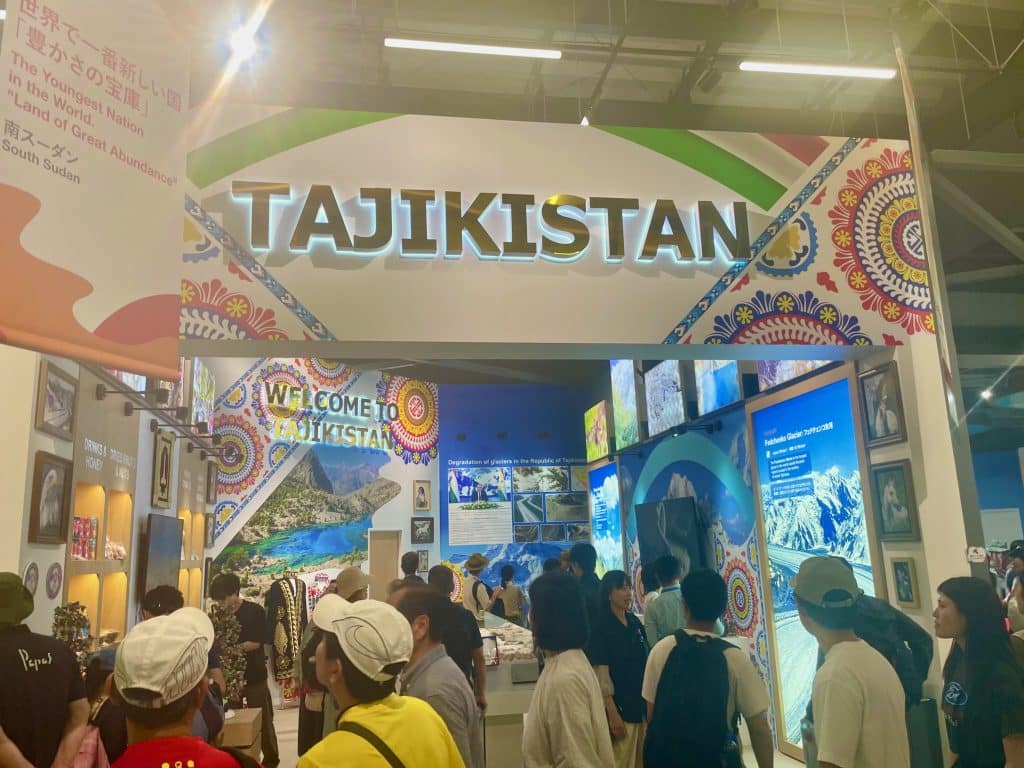
Sensory Overload
We decided to visit Commons D, which features 25 countries. Looking back, it would have been better to start with Commons C (see below), since it is smaller and easier to take in while getting a feel for the layout. After wandering through the individual pavilions in the hot sun, the idea of exploring 25 nations in one space felt overwhelming at first. It was like trying to navigate through a cluster of shops at a crowded airport.
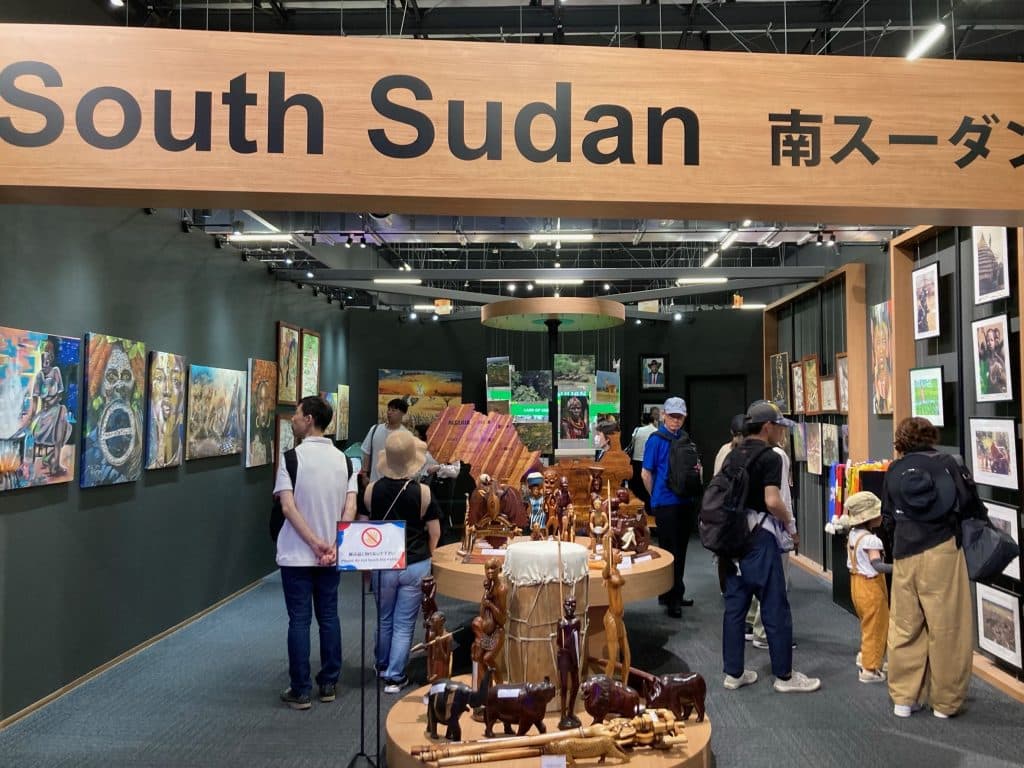
A Calmer Approach
Once I got acclimated to my surroundings, I was able to leisurely stroll to many of the pavilions at my own pace. You really need to give yourself at least 45 minutes to an hour to experience the Commons to the fullest. If you are pressed for time and have to decide between waiting in line for one country, I would definitely go with the Commons because you can see so much more in the same amount of time.


The Power of International Exchange
I had the chance to visit the pavilions of Tajikistan, South Sudan, Cuba, Togo, Belize, Marshall Islands, and São Tomé and Príncipe. Although I only spent a short time in each one, I came away having learned something new about every country. São Tomé and Príncipe especially stood out to me, as I have to admit I had never even heard of it before. It was also heartening to see Japanese people of all ages (especially young schoolchildren) engaging so positively with people from different parts of the world.
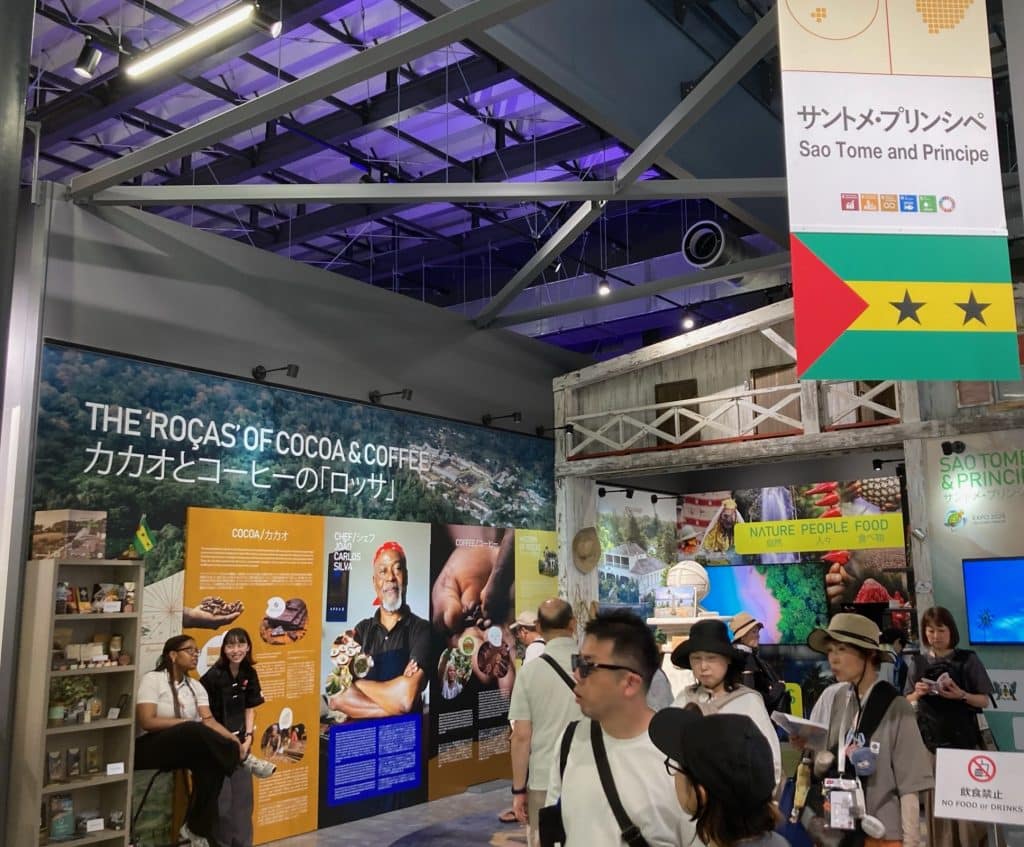

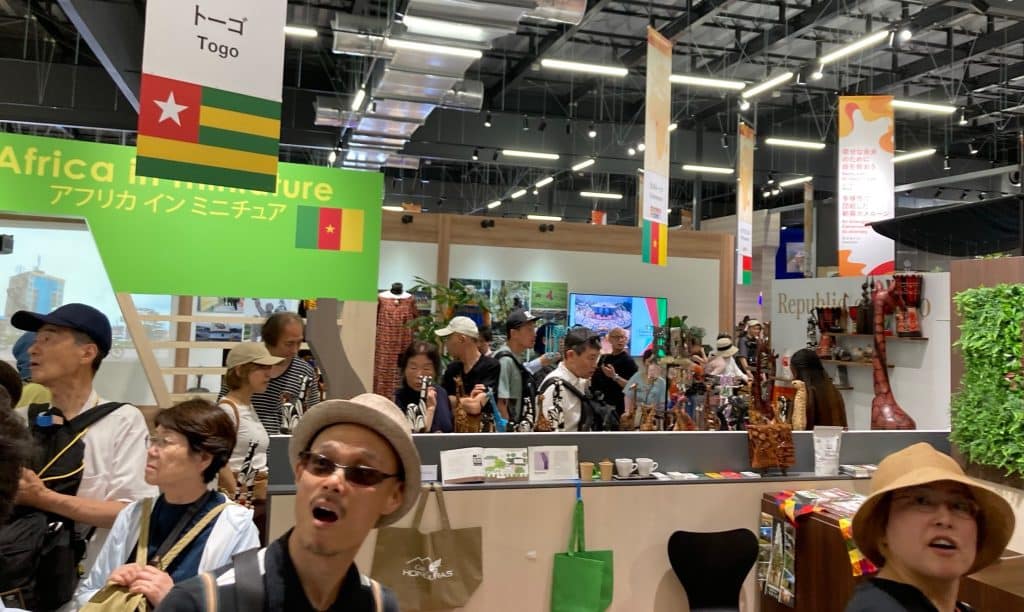
Photo Ops
Most of the staff have been working at the Expo since May, so it’s understandable that they can’t be present every moment of the day. Sometimes you’ll find a Japanese volunteer running a pavilion, other times an actual representative from the country. Either way, if you ask politely, they’re usually more than happy to take a photo with you. All of these small interactions have meaning.


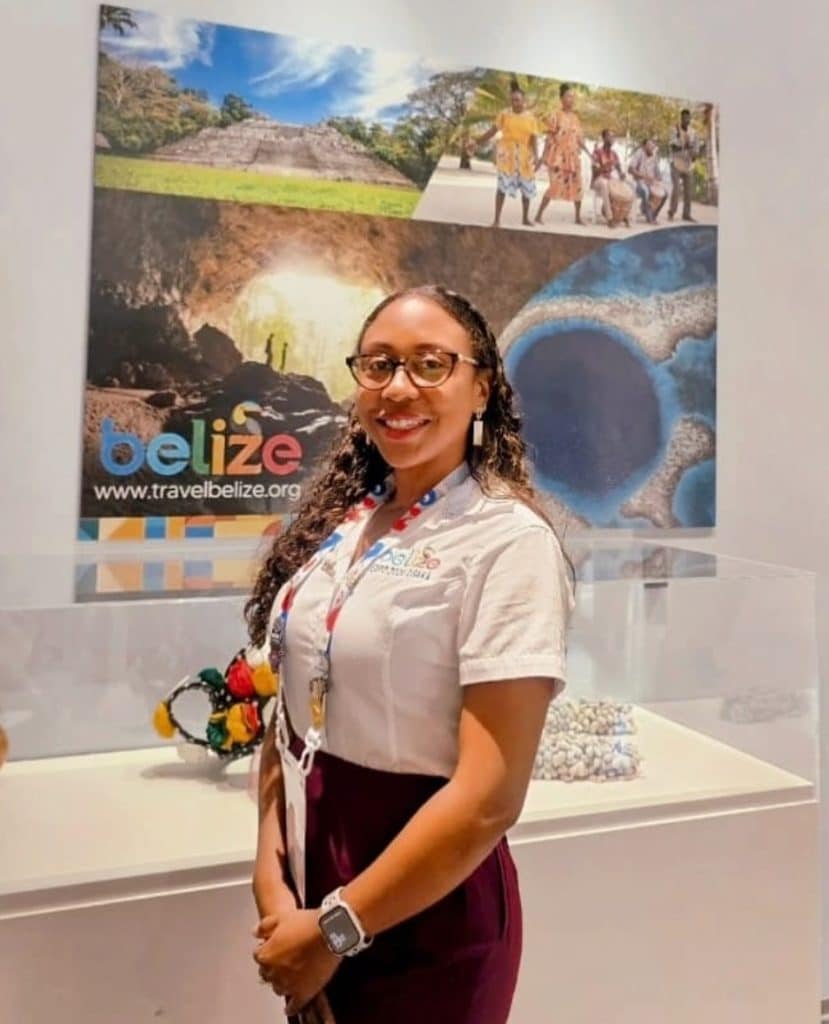
13:20 China Pavilion
It started to rain just as we waited in line at the China Pavilion, which is one of the largest structures at Expo 2025, covering 3,500 square meters. The exterior design of the pavilion is inspired by bamboo slips and shaped like an unfolded Chinese calligraphy scroll. Thin slips of bamboo were used in China before the widespread use of paper.
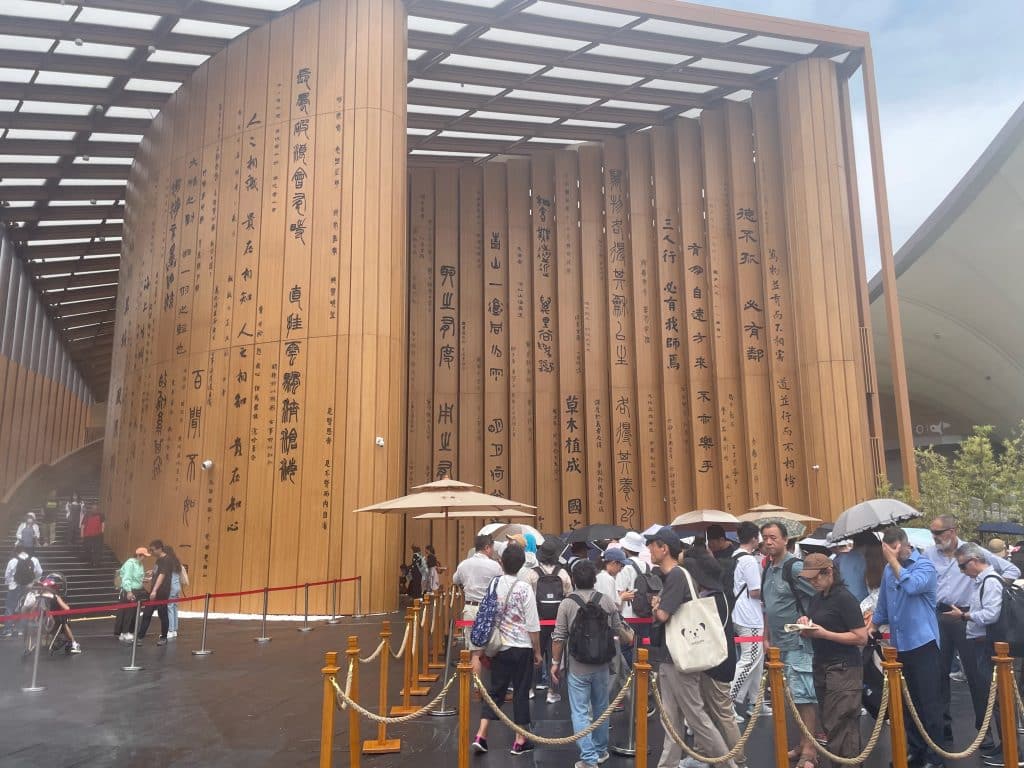
Digital Art: The 24 Solar Terms
Once inside I watched a digital presentation on The 24 Solar Terms, “divisions in the year used in traditional Chinese agrarian c culture marking climatic and seasonal changes.” Chang Shana (常沙娜), the Pavilion’s chief art advisor, is an artisan who is known for traditional Chinese patterns inspired by Dunhuang mural art found in cave dating back the the 4th century.

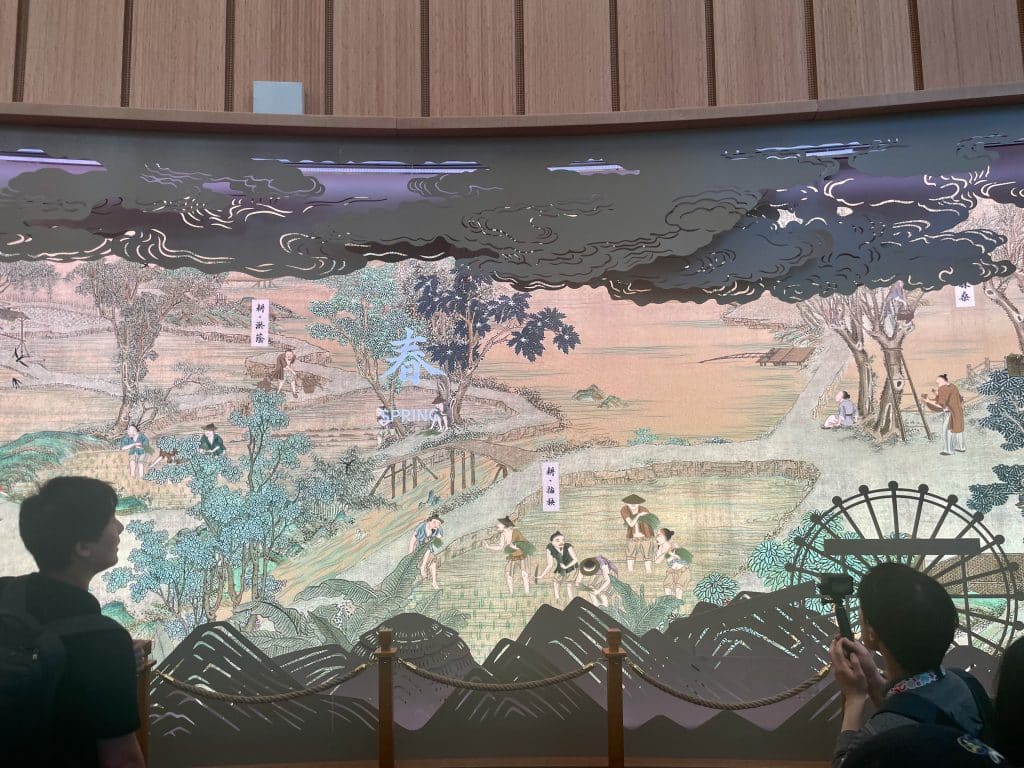
Jialong Deep-Sea Submersible
Jialong, which means “flood dragon” is a deep-sea research submersible capable of diving to depths exceeding 7,000 meters. The China Pavilion contains a life-sized replica of Jialong with high-definition panoramic screens so that visitors can experience what its like to explore the deep sea. The interactive experience was quite popular with children and there was a bit of a line, so I skipped it, which I kind of regret now.
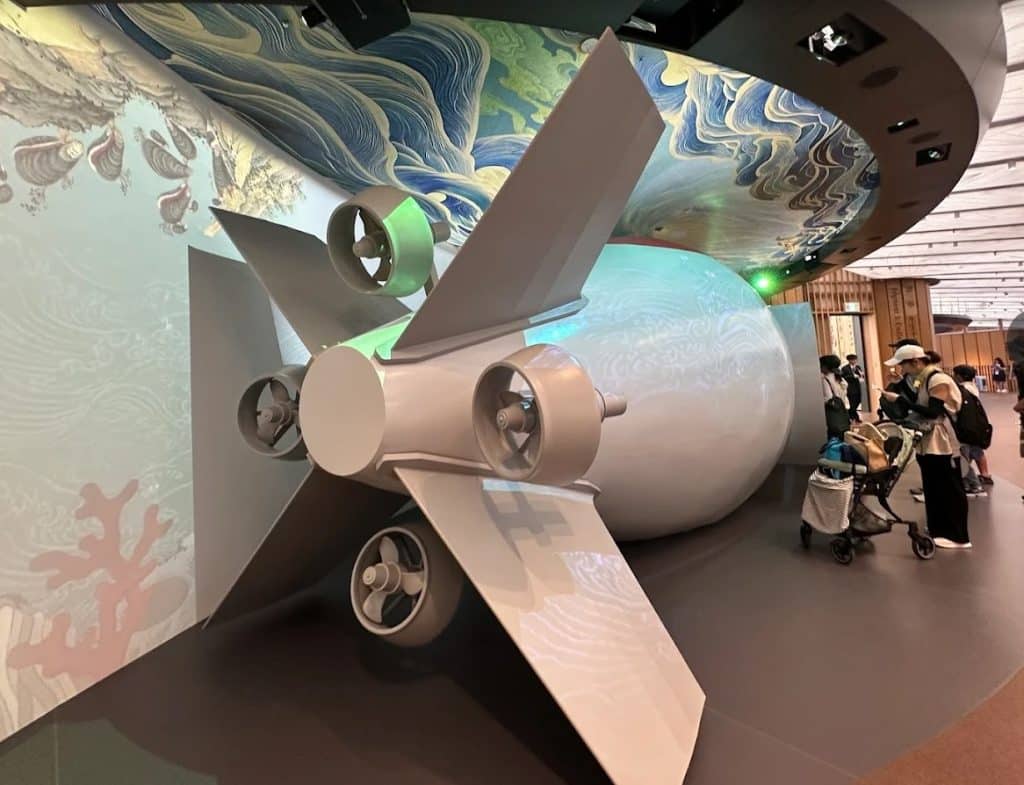
Lunar Soil from Chang’e-5 & Chang’e-6 Missions
Chang’e-5 and Chang’e-6 are unmanned robotic space probes that brought back lunar soil and rocks from the near side and far side of the Moon in 2020 and 2024 respectively. The latter mission marked the first time that lunar soil from the far side had been brought back. The lunar soil from both sides are displayed in clear protective enclosures and visitors can observe the differences through magnification. I wasn’t able to get good photos of the lunar soil so this shot of the Moon will have to do.
Tip: You will enjoy this experience a lot more while listening to Dark Side of The Moon by Pink Floyd on proper headphones.

Wooden Mural: China-Japan Friendship
A wooden relief mural depicting China-Japan friendship can be found in the corridor connecting two floors. It includes the friendship between Tang Dynasty poet Li Bai and Japanese scholar Abe No Nakamaro and a symbolic pairing of Sun Wukong (Monkey King) with Astro Boy.

Exit Through The Gift Shop
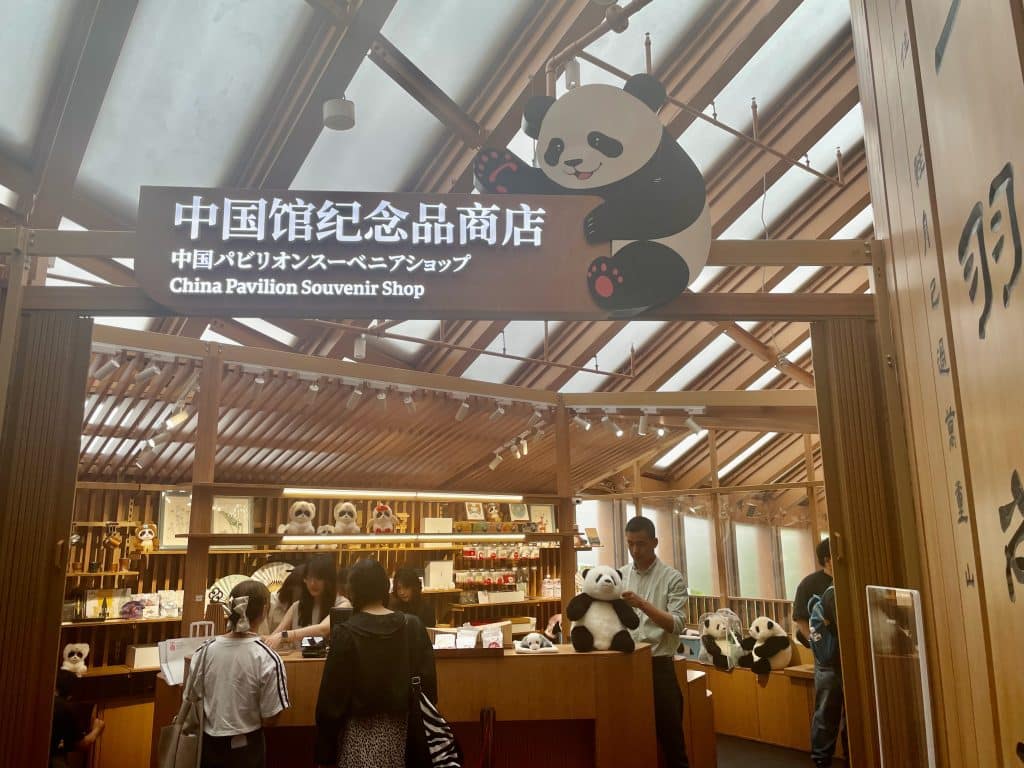
Japan only has two giant pandas left at Ueno Zoo ever since four giant pandas from Wakayama’s Adventure World returned to China at the end of June. It’s only fitting that one of the most popular items at the gift shop at the China Pavilion are plush panda dolls, which are priced between ¥49,800 ($320) and ¥76,000 ($490). Despite the high prices, these panda dolls have sold out multiple times.

14:00 Break Time
It was time to take a 30-minute break outside and eat some of the snacks we brought along. We found a quiet area with benches in the shade. Here are some of the things we saw along the way. Of course I had to get a photo in front of the Expo 2025 sign.

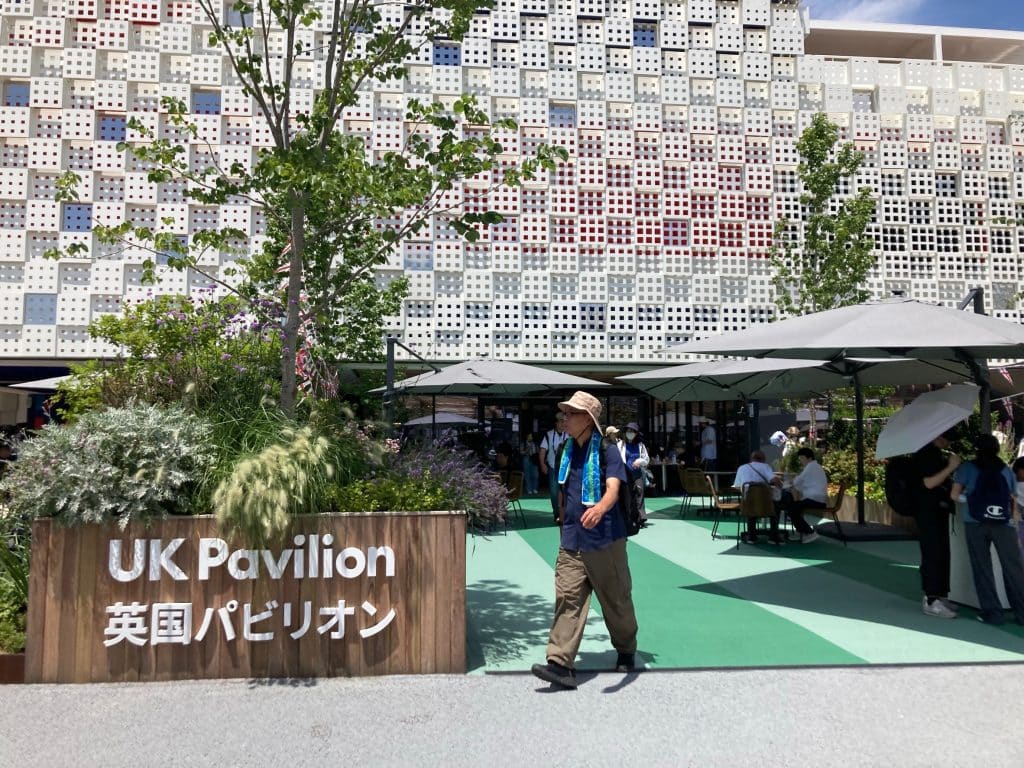
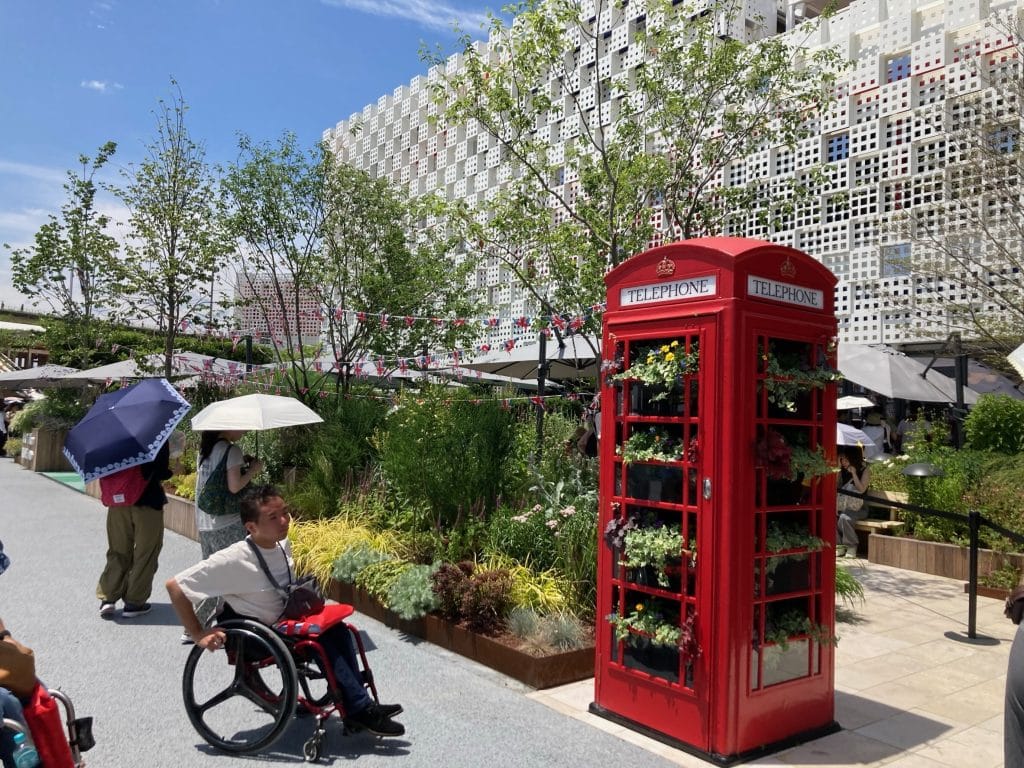


Dynamic Equilibrium of Life Pavilion


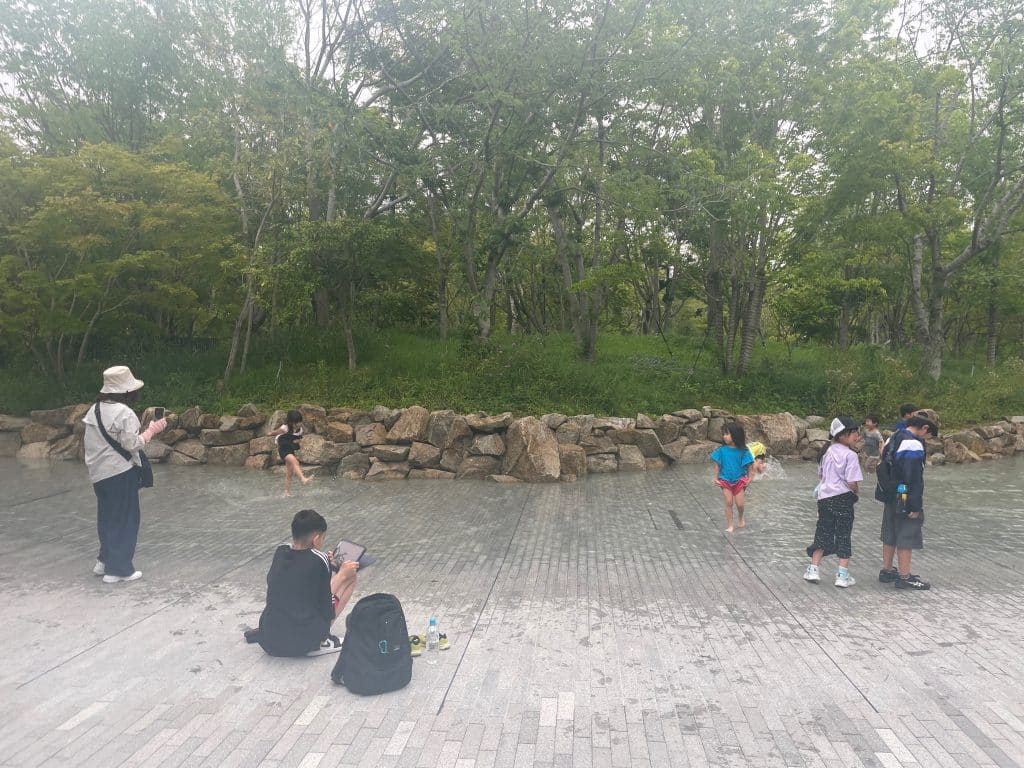
14:30 Lunch Time
It was time for lunch. I had wanted to eat at the African Food Court but it was just too crowded and we didn’t feel like waiting. We looked at the menus at a couple of the pavilions but the food was like pizza, chicken nuggets and French fries and out of our budget. I’m willing to pay full price for something out of the ordinary, not greasy fast food I can get at any sporting event.
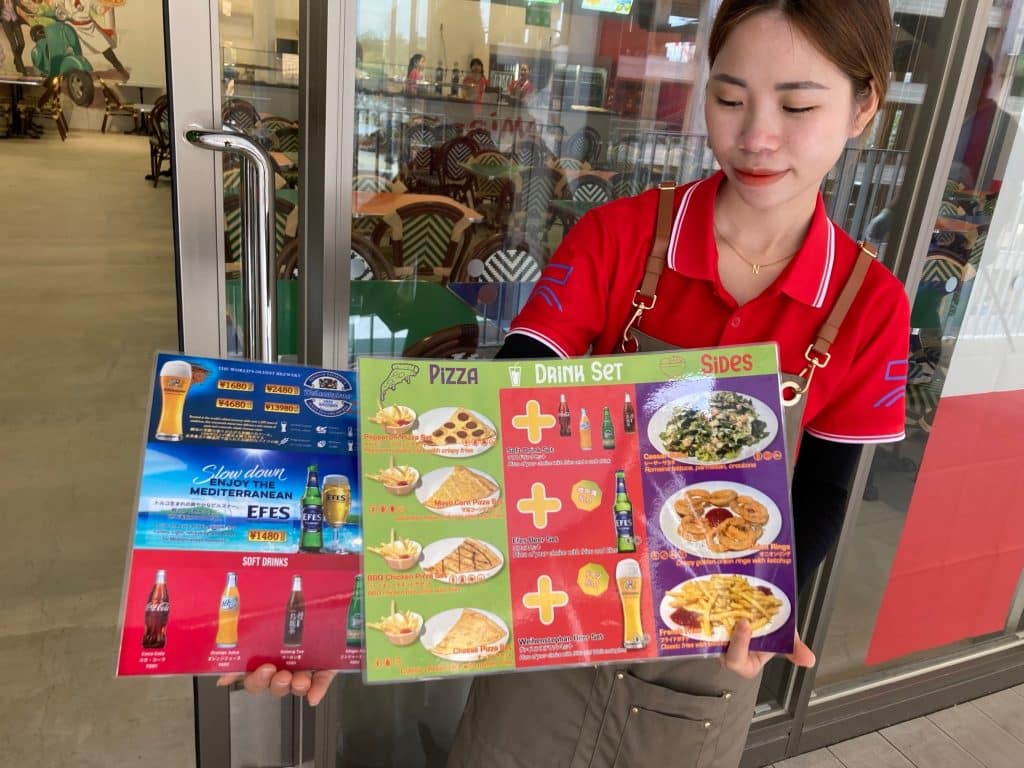

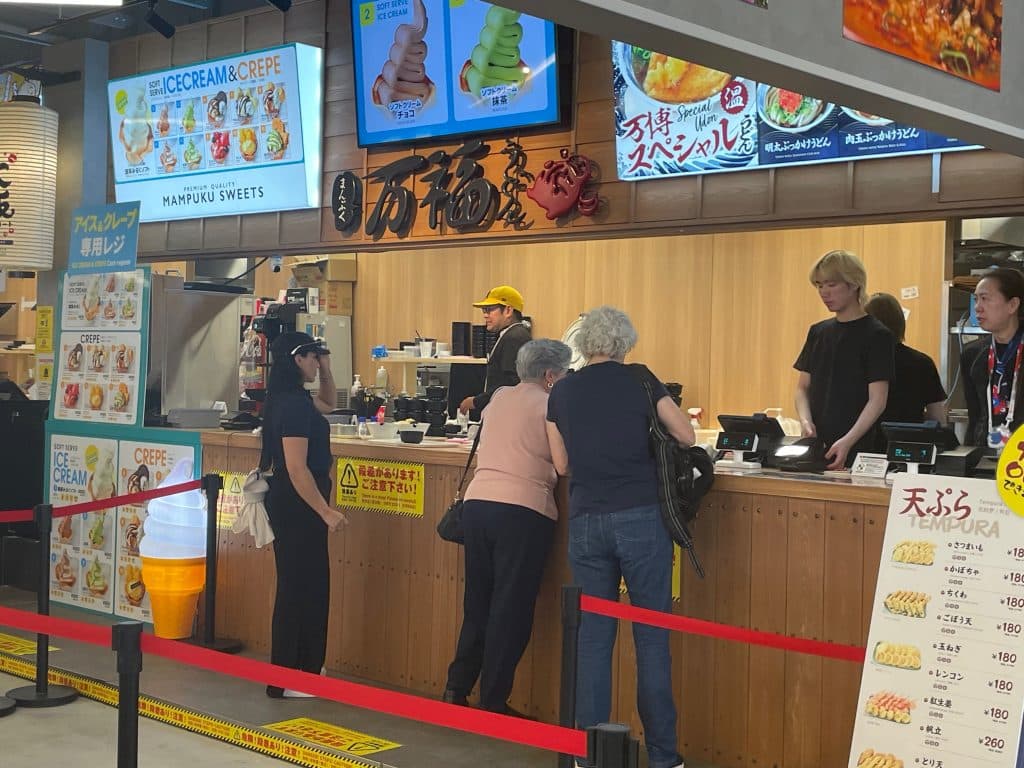
In the end, we decided to eat at the food court on the second floor. I ordered a tonkatsu egg dish covered in sauce and really didn’t think much of it one way of the other. But then I looked around and saw that a lot of the people were enjoying their meal. For some of the foreign visitors, it might be the very first time they tried an Osaka speciality like takoyaki. Sometimes the food doesn’t have to be the best if the meal is attached to great memories. I bet there are Japanese people who still remember the meal they had at Expo 70 in Osaka 55 years ago.

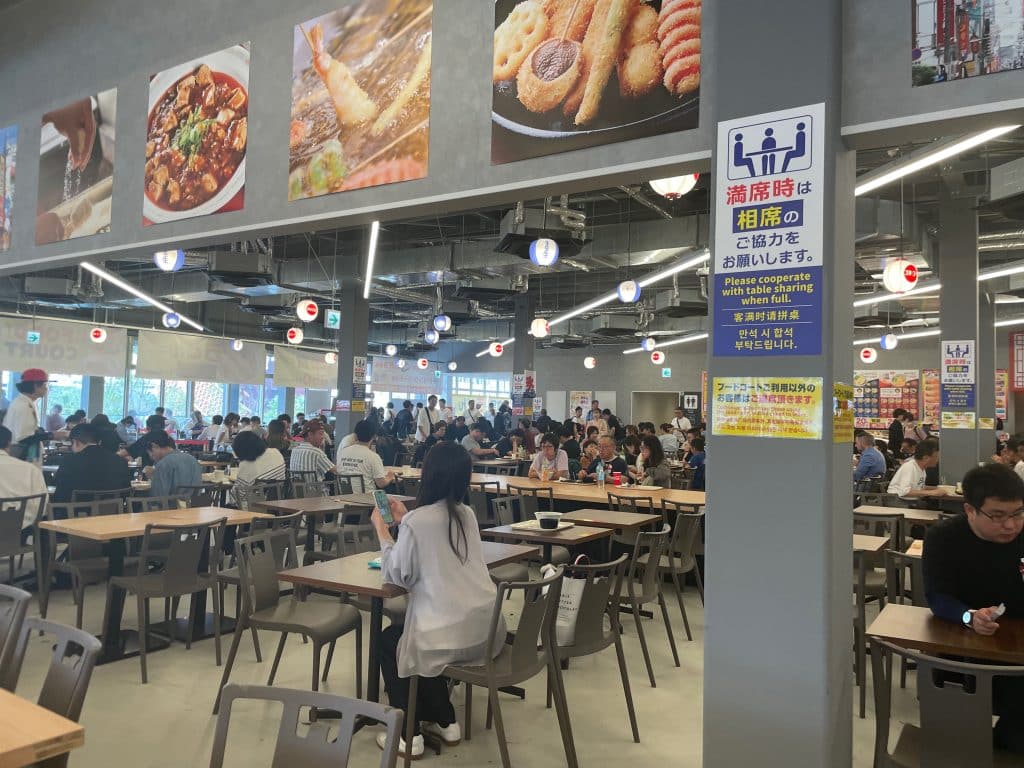
15:40 Kuwait Pavilion
As we passed the Kuwait Pavilion, we ran into friends we hadn’t seen in years, a Bulgarian-Japanese couple from the next town over. When we mentioned our disappointment over our failed reservations, they told us they had a special invite from a friend who works at the Expo and insisted we join them. After their friend arranged credentials for us, we were whisked inside. I felt a little guilty skipping ahead of everyone in line, but I did the walk of shame anyway. Sometimes, you just have to take the gift horse by the mouth.
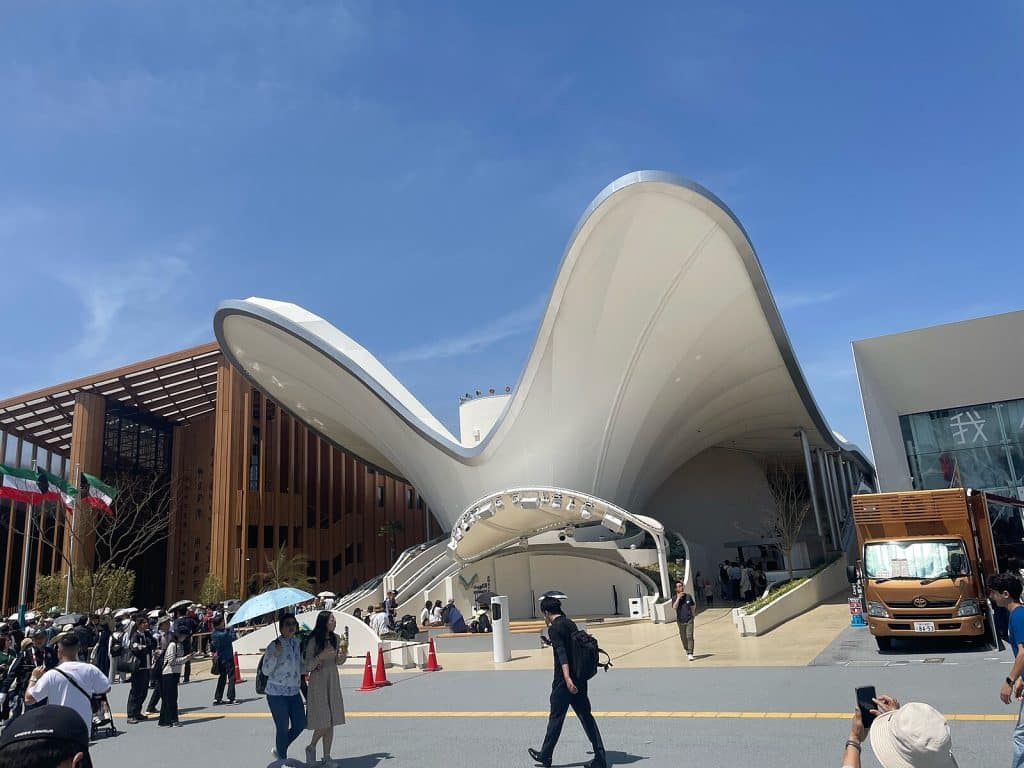
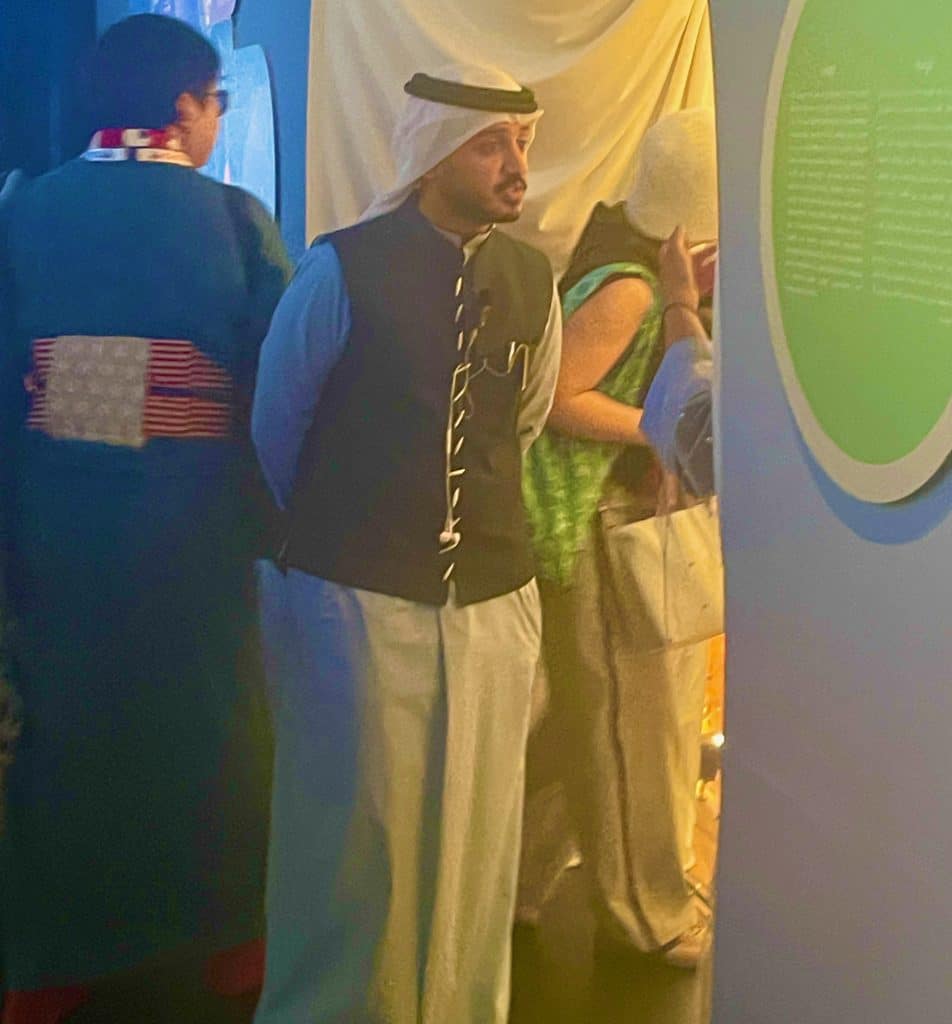
Kid-Friendly Hospitality
One thing I really appreciated about this pavilion was seeing half a dozen Kuwaitis walking the floor, personally greeting each visitor in English and Japanese. We explored scenes of everyday Kuwaiti life and followed a timeline of the country’s history. The pavilion was incredibly kid-friendly, featuring a sandbox, a sliding pond, and hands-on interactive activities. It was also fun to see that visitors could try on traditional Kuwaiti clothing.
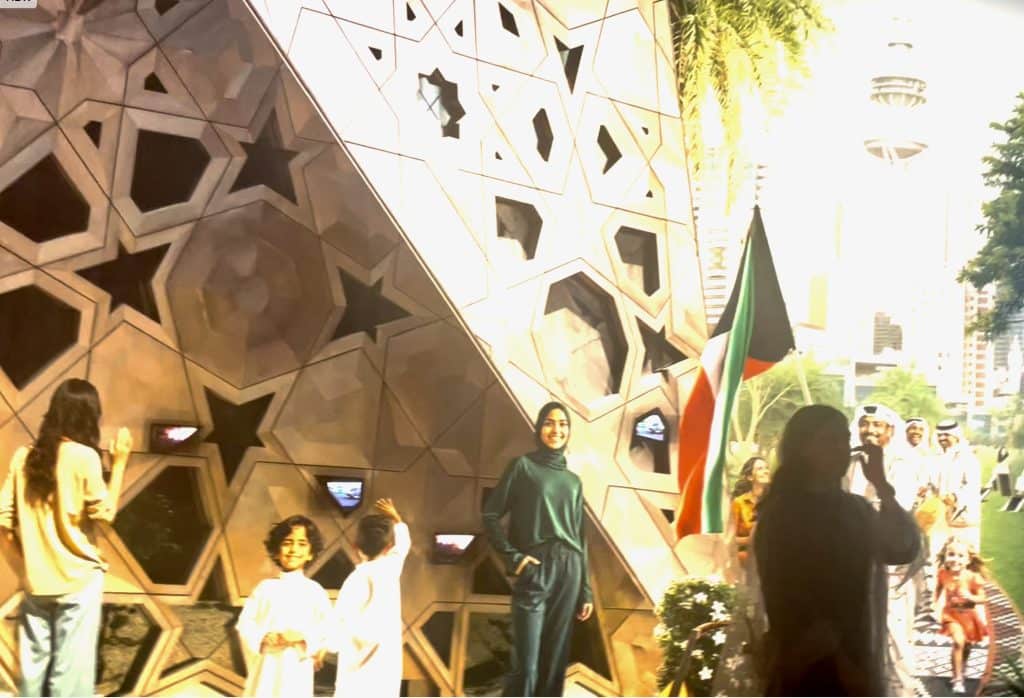
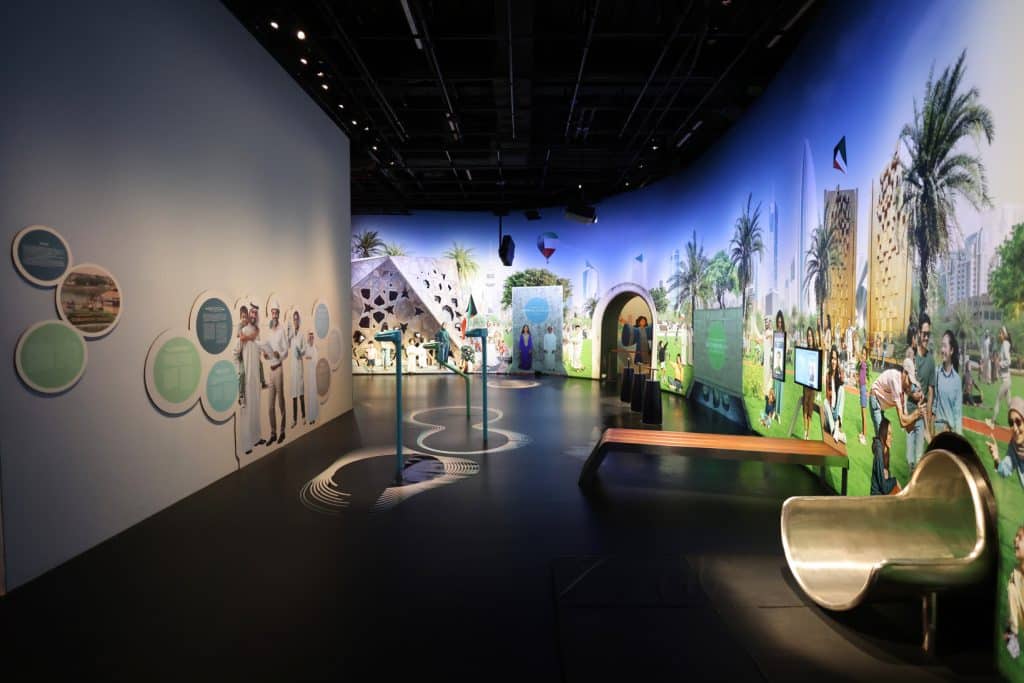
Dome Theater
We watched an animated pre-show featuring a Kuwaiti girl, a stork, and a robot, which narrated highlights of Kuwait’s history. It had a strong Epcot Center vibe and was a hit with visitors. After touring the pavilion, I learned they have a restaurant on-site called Sidra that serves traditional dishes like Makbus with lamb. I’ve never tried Kuwaiti cuisine before, and now I wish we had eaten there instead of heading to the food court. It’s a good reminder that planning ahead can make all the difference.
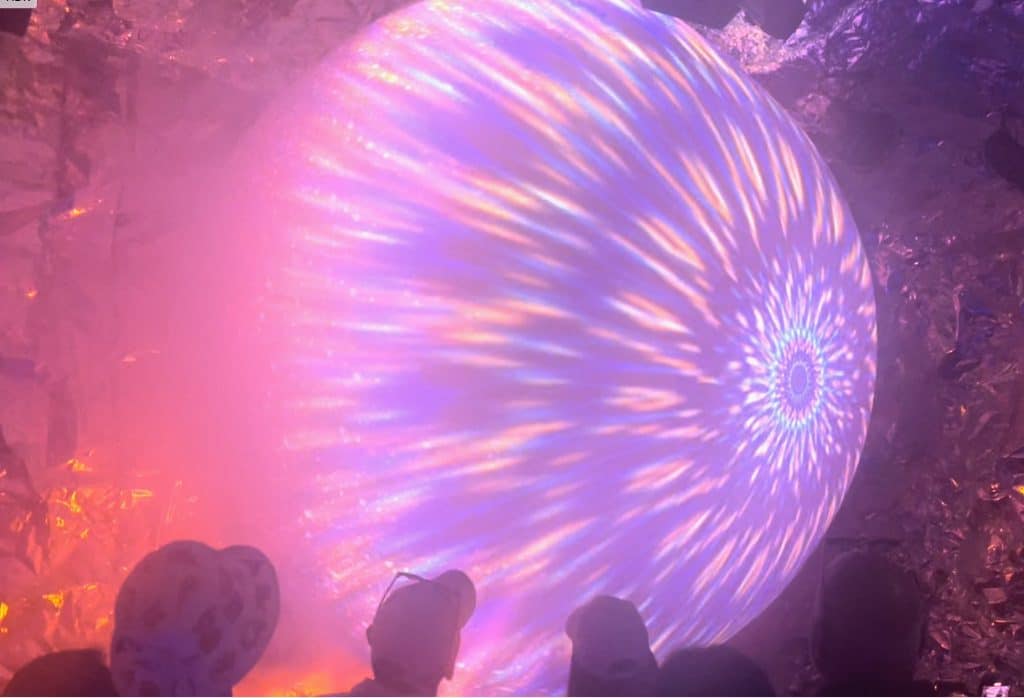
16:30 Commons C: Ukraine Pavilion
Commons C hosts pavilions from 11 nations, but we only had time to visit one. We made a brief stop at the Ukraine Pavilion, which featured a striking “Not For Sale” display of 18 items from the country. Visitors could scan the items’ barcodes with a smartphone-like device to view videos showing daily life in Ukraine during wartime, such as children studying in a subway station while taking shelter from bombings. You can find out more about the Ukraine Pavilion from this NHK World program.

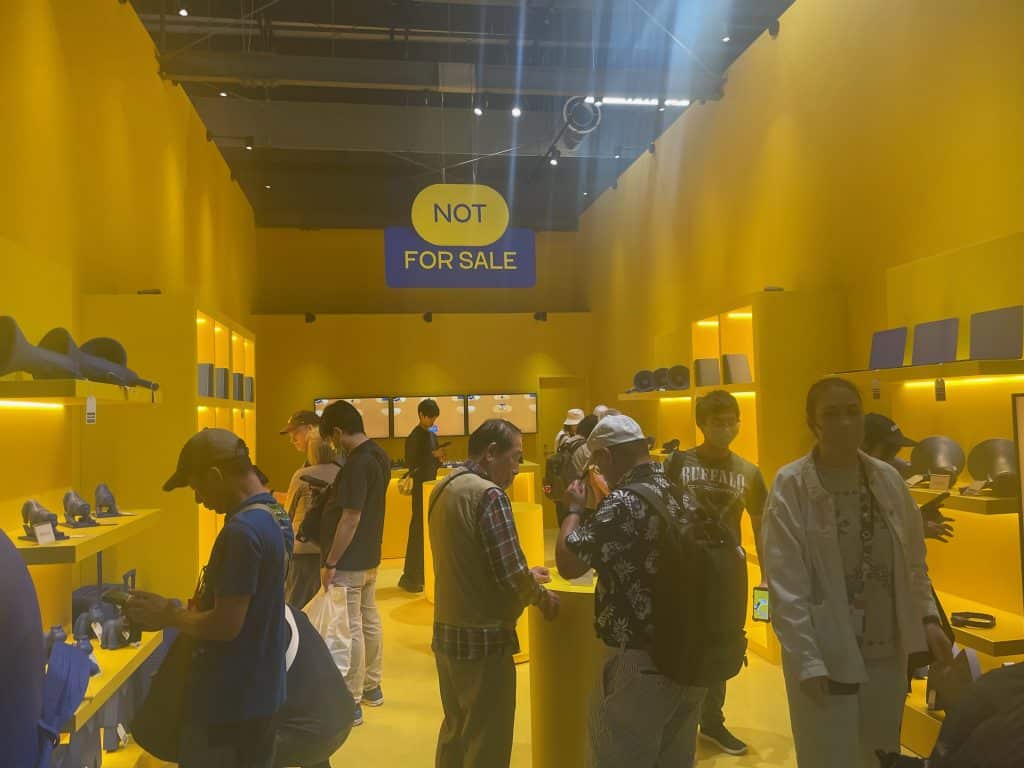

17:00 The Grand Ring
The Grand Ring has officially entered The Guinness Book of World Records as the largest wooden structure in the world. The 12-meter high walking course covers an area of approximately 60,000 square meters. It circles the central zones of the Expo around all of the major pavilions. Japan doesn’t have many boardwalks that I know of, so it was a nice feeling to walk around a wooden structure. It’s especially enjoyable at night when the grounds of the Expo are lit up. And the view is magnificent, you can see all of Central Osaka and Osaka Bay on a clear day from some of the higher points. I hope they don’t tear it down.
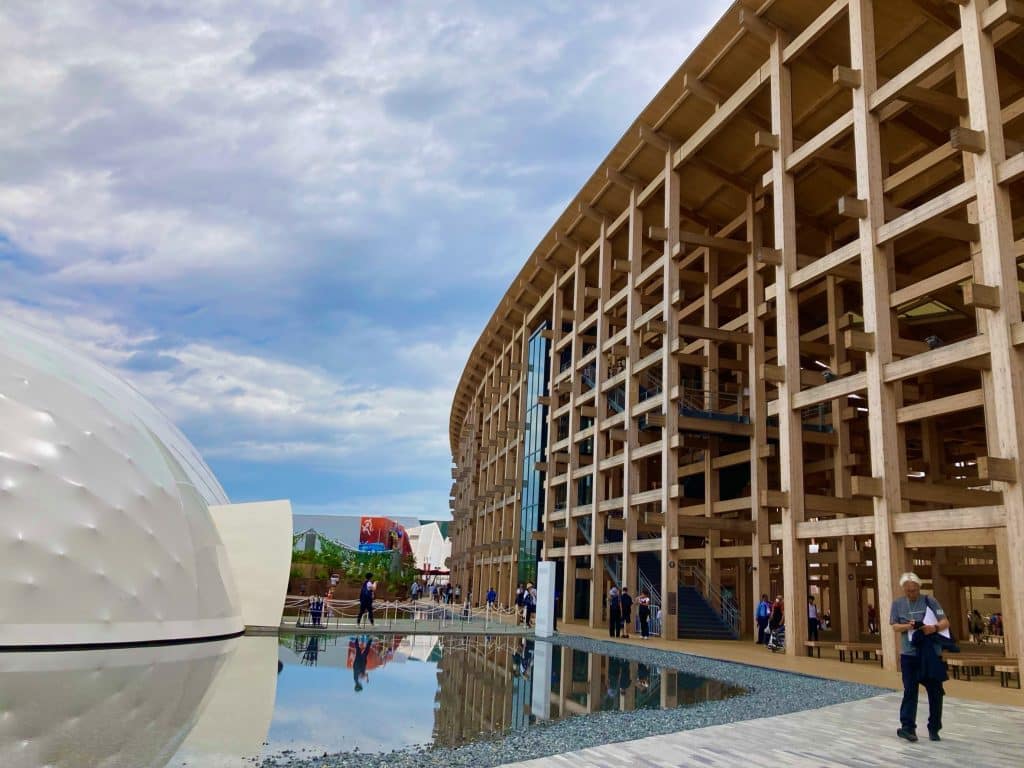

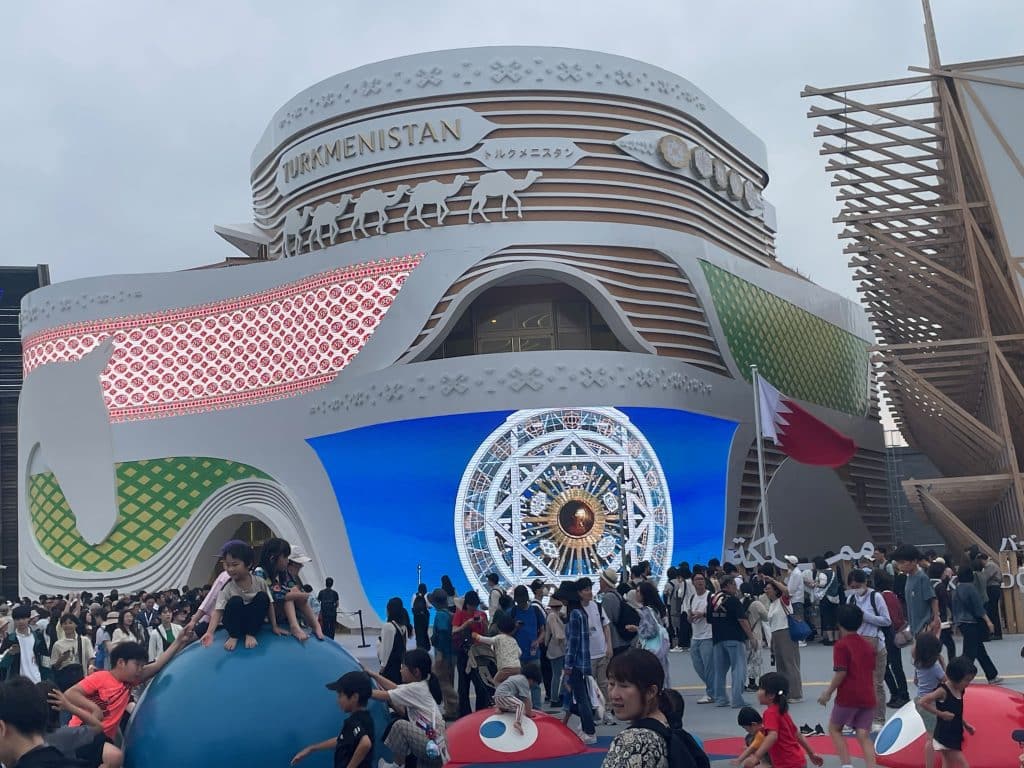
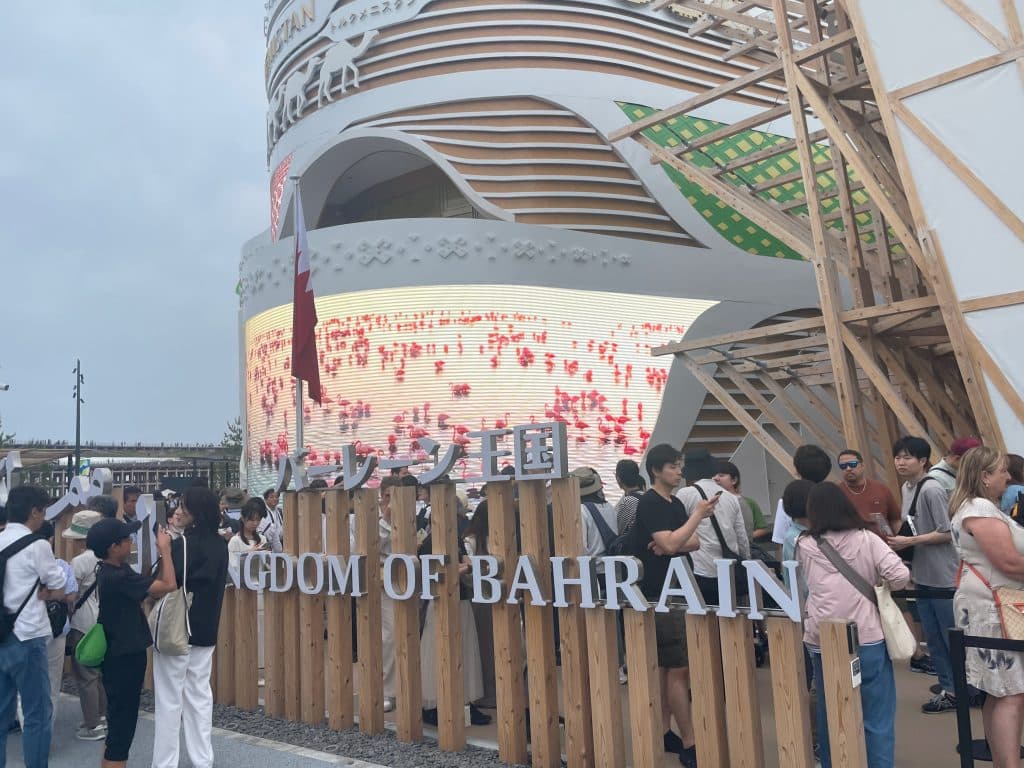

18:10 Commons B

After our evening stroll along The Grand Ring, we visited Commons B, which consists of 26 Pavilions. This proved to be one of the best decisions we made all day because we ended up having a great time inside. We even managed to eat dinner there without having to wait in a long line. If you have to choose only one of the Commons, I heartily recommend Commons B.
Zambia Pavilion
The Zambia Pavilion was packed, with cheerful staff warmly welcoming every visitor. The positive energy in the room was almost contagious, drawing even more people inside. It’s impressive that they bring the same enthusiasm day after day for six months, with each one offering a new chance to share their country and culture with a different audience.

Ivory Coast Pavilion
At the Ivory Coast Pavilion, I witnessed on of the staff answer questions from a teacher and her students. Expo 2025 is free to all students in Osaka, and it was nice to see curious minds learning about other cultures and experiencing intercultural communication up close.

Chad Pavilion
Many of the pavilions relied on Japanese staff and volunteers, who had to become mini experts on the countries they were assigned to in order to answer numerous questions from visitors. I saw this dedication at the Chad Pavilion, where a young Japanese staff member patiently answered questions from a visitor with confidence and poise. His hard work paid off.
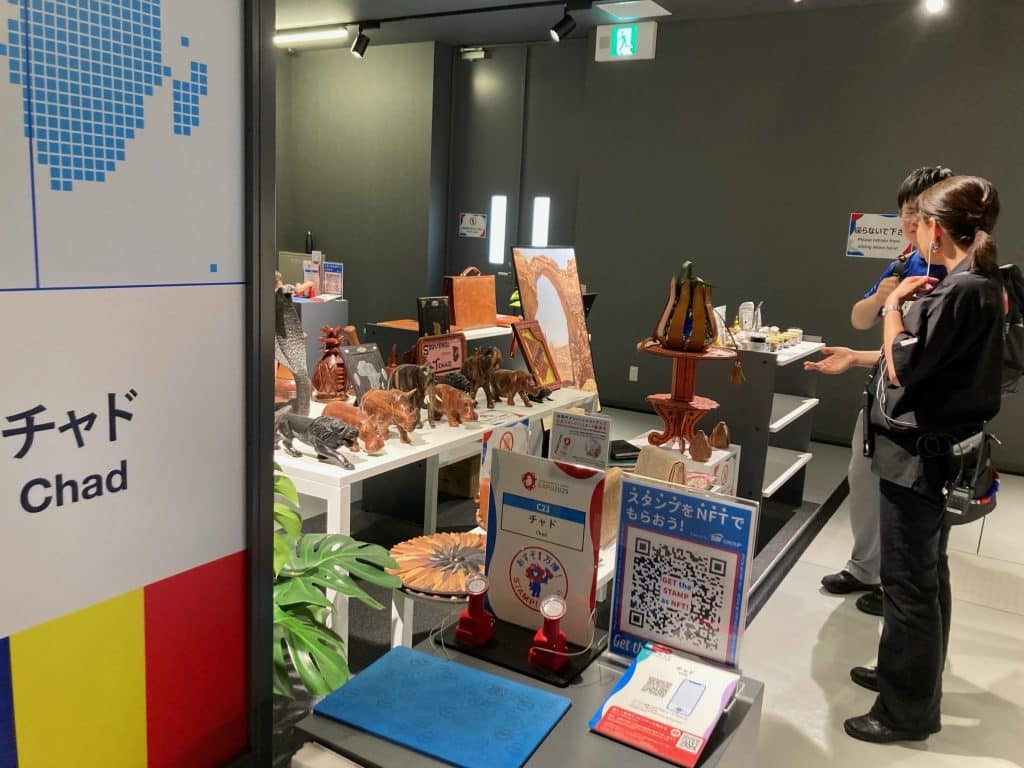
Mauritania Pavilion
While many of the larger pavilions outside relied heavily on digital presentations and artificial intelligence at times, it was nice to see that many of the smaller pavilions here brought tangible props, such as this life-size camel in the Mauritania Pavilion.

Benin Pavilion
I saw a dedicated staff member from Benin with impressive Japanese language skills personally guiding almost every visitor who stopped by the exhibits. At one point he noticed a couple who didn’t seem to be following along, so he asked if they were having trouble understanding his accent. They replied, “We’re from Korea, but keep going because we can understand most of what you are saying.” It was a reminder that people from all over the world, not just Japanese visitors, are attending this event.
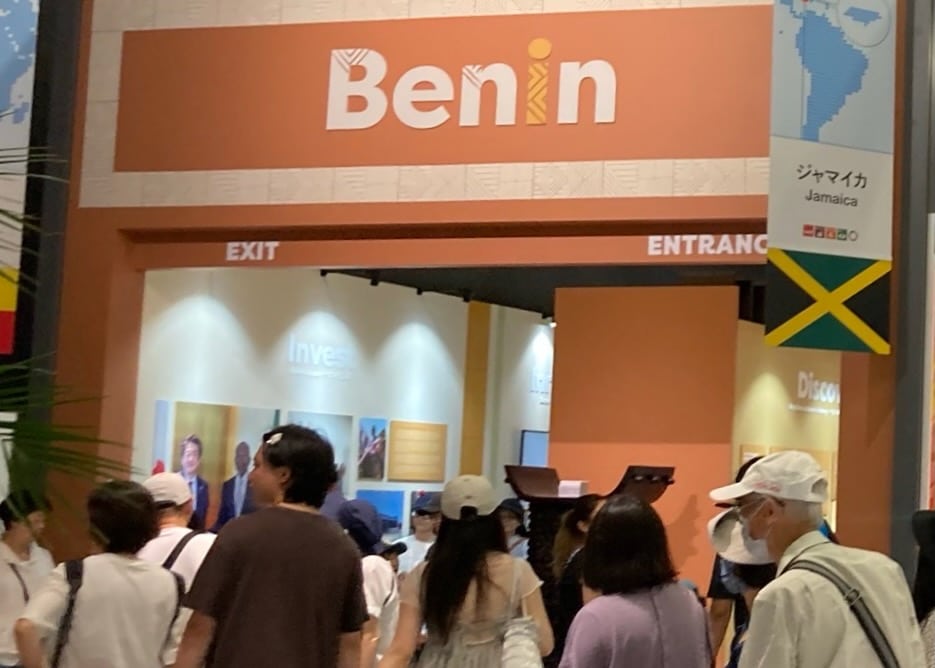
Jamaica Gets The Gold Medal!
If I had to give a medal for the best pavilion in all of the Commons, it would go to Jamaica. The designers of this space clearly understood the assignment. Bright, eye-catching illustrations on the walls seemed to call out, “Step inside, visitors of all ages, this is where the party is! If you can’t come to Jamaica, then we’ll bring Jamaica to you! Who could resist such an invitation?
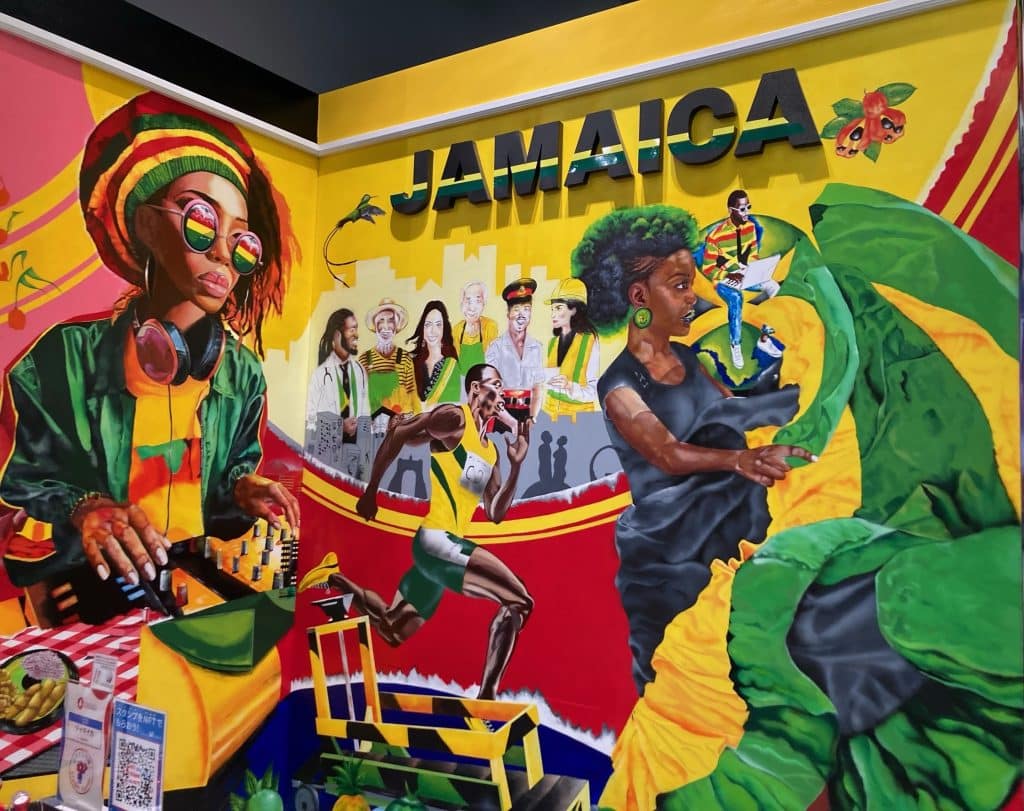
Instead of the usual laminated posters listing dates and historical facts, the Jamaica Pavilion showcased vintage posters celebrating the country’s greatest cultural exports: reggae and dancehall. Walking inside felt like stepping into a Kingston club, the only things missing being a bottle of Red Stripe and a plate of jerk chicken.

Bob Marley: Legend
Visitors could also pose with a life sized statue of the Legend himself, Bob Marley, whose songs are played throughout Japan, from Okinawa to Hokkaido on a daily basis. Kudos to the artist who designed this statue because it was incredibly life like. I’m sure many visitors who are still unfamiliar with the reggae kings body of work, will take the time to seek out his music after visiting this pavilion.
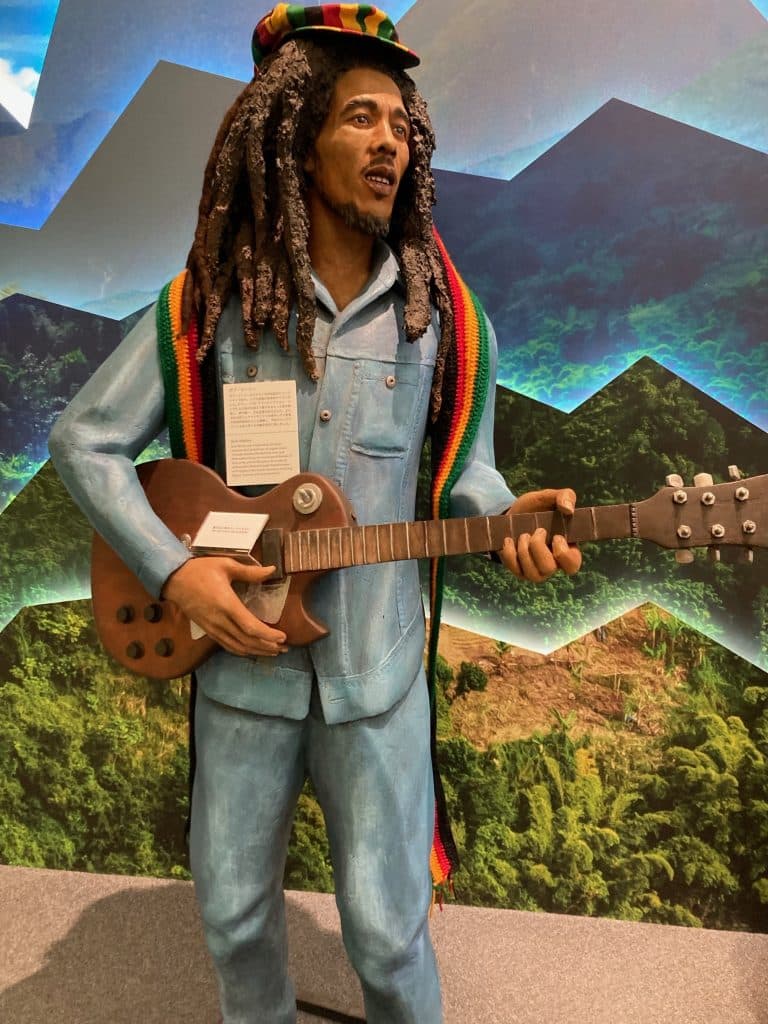
Usain Bolt: The Fastest Man Alive
Usain Bolt is widely regarded as the fastest man in history. The sprinter, nicknamed The Lightning Bolt won eight gold medals in the Olympic and setting world records in the 100 meters (9.58 seconds) and 200 meters (19.19 seconds) which have stood in place since 2009. The statue of Usain Bolt was prominently featured on the center wall. It was created by Jamaican artist Scheed Cole, who also made the Bob Marley statue.
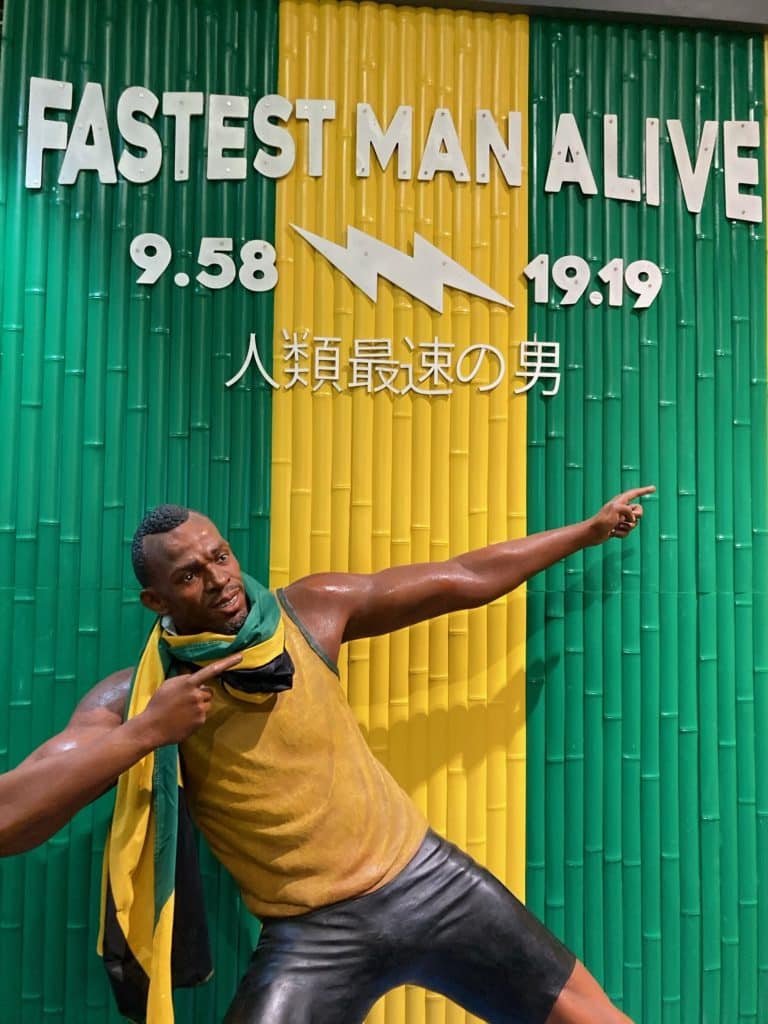
Cool Runnings: The Jamaican Bobsled Team from the 1988 Winter Games
There’s almost no better underdog story than the story of the Jamaican Bobsled Team, who against the odds, competed at the 1988 Winter Olympics in Calgary, Canada. Even though they did not recieve a medal, their spirit and perseverance won over fans around the world and inspired the hit film Cool Runnings. Their story was even featured in a Japanese junior high school English language textbook a few years back if I remember correctly. The bobsled on display at the Jamaica Pavilion is a real training sled, on loan from the Jamaica Bobsleigh and Skeleton Federation.
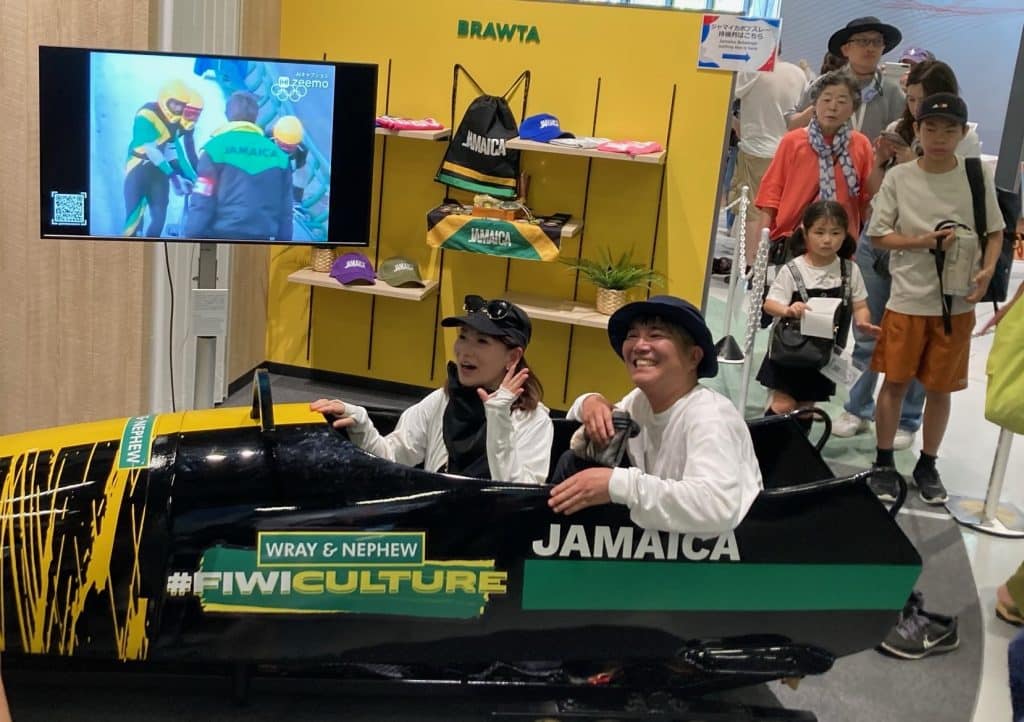
Meeting Commissioner General Maureen Smith
About a week later, while enjoying a plate of jerk chicken and a cold Red Stripe at my favorite Jamaican restaurant, I noticed a customer from Jamaica wearing an Osaka, Japan T-shirt. Excited, I told her I had just been to Expo 2025 and spent a full minute raving about how much I loved the Jamaican Pavilion. She smiled, then introduced herself as Maureen Smith, Commissioner General of the Jamaica Pavilion at Expo 2025. I had been enthusiastically describing the pavilion as if she hadn’t seen it yet, only to realize she was the very person who had come up with the concept!

Dinner at The Gambia Pavilion
By this time, we were rather hungry, but didn’t have concrete plans for dinner. Then we noticed that The Gambian Pavilion was offering a traditional dish called Benachin, a jollof rice dish with shrimp. My wife really wanted to try this, so I ordered the Gambian Domoda. Then we decided, why not order the Chicken Afra so we could brag that we ordered everything on the menu. It came to exactly ¥5,000 but when are we going to get the chance to eat Gambian food again? All the dishes we had were tasty and I’d like to learn more.

Unfortunately, right after we finished our meal, we noticed that both of our phones had run out of power. Once again, I cannot stress the importance of bringing a mobile battery along. It was a shame because I really wanted to take original photos at the next pavilion.
19:10* Saudi Arabia Pavilion
*This part of the article occurred after both our phones died so I am not sure of the exact time.
It seems like it is much easier to get into popular pavilions in the evenings without a reservation as the crowds dissipate. We were overjoyed to get into the Saudia Arabia Pavilion without much of a wait because it was on the top of our list. The pavilions structure mirrors a traditional Saudi village with narrow alleys and a courtyard in the center.
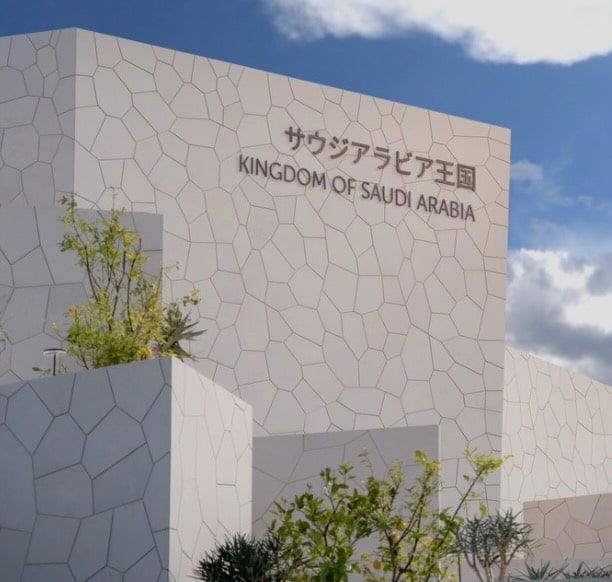
The court is filled with native trees and plants that were shipped over from Saudi Arabia. A tall gentleman dressed in traditional Saudi clothing was on hand to greet all of the visitors waiting in line. This was the one Pavilion I experienced that really felt like taking a trip overseas. Once inside we were greeted by other staff walking around the premises. It was off to a good start.
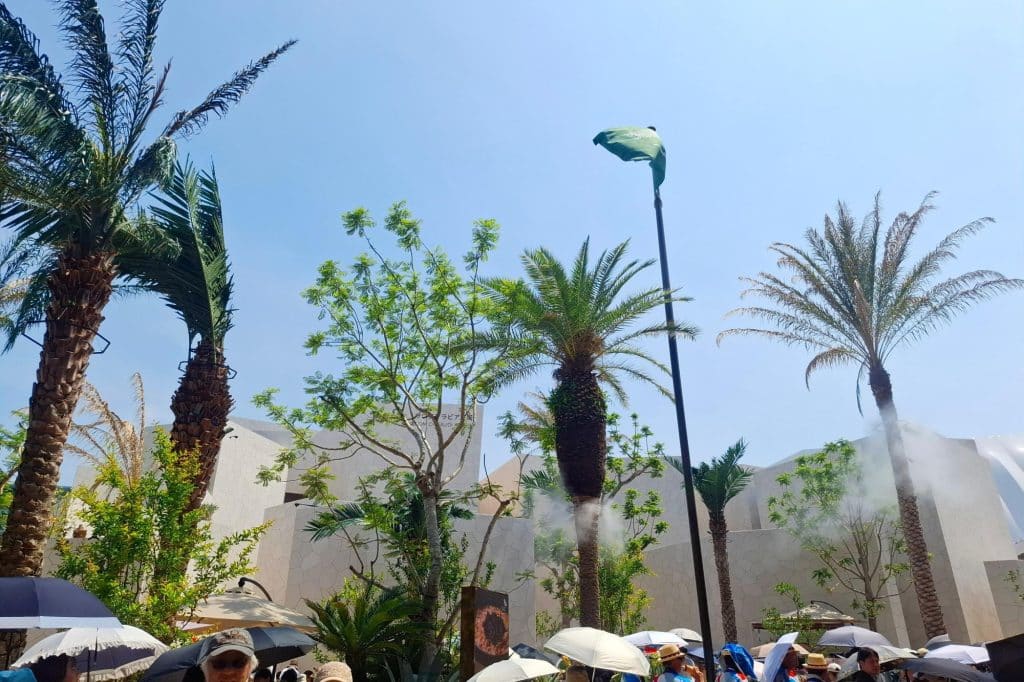
Manami Hirai and Saleh: Tales of Water
At night the main courtyard is transformed into a stage for cultural shows and musical acts. Before the performance we watched a video about the Saudi arts scene that were projected over walls of the courtyard that towered above the small stage. We had no idea what would happen next and there was a sense of excitement in the air. What happened next was one of the best musical performances I have ever witnessed.
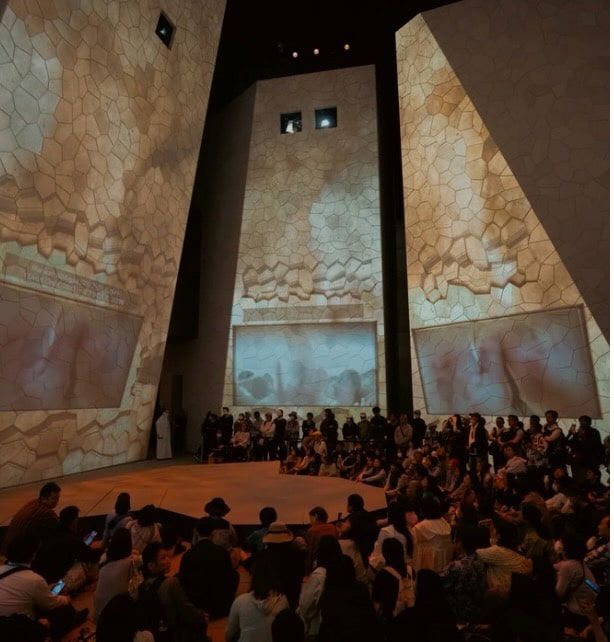
A Japanese cellist took the stage and started playing. I found out later that her name is Manami Hirai and she has played with artists such as Sarah Brightman, Mrs Green Apple, Yoshiki of X Japan and Eikichi Yazawa. She was soon joined by a Saudi singer named Saleh who sang a beautiful, haunting song. The Japanese and Saudi musical styles flowed together seamlessly and by the end of their performance I was moved to tears. A full video posted by Fuji Travel can be found here.
A Remarkable Collaboration
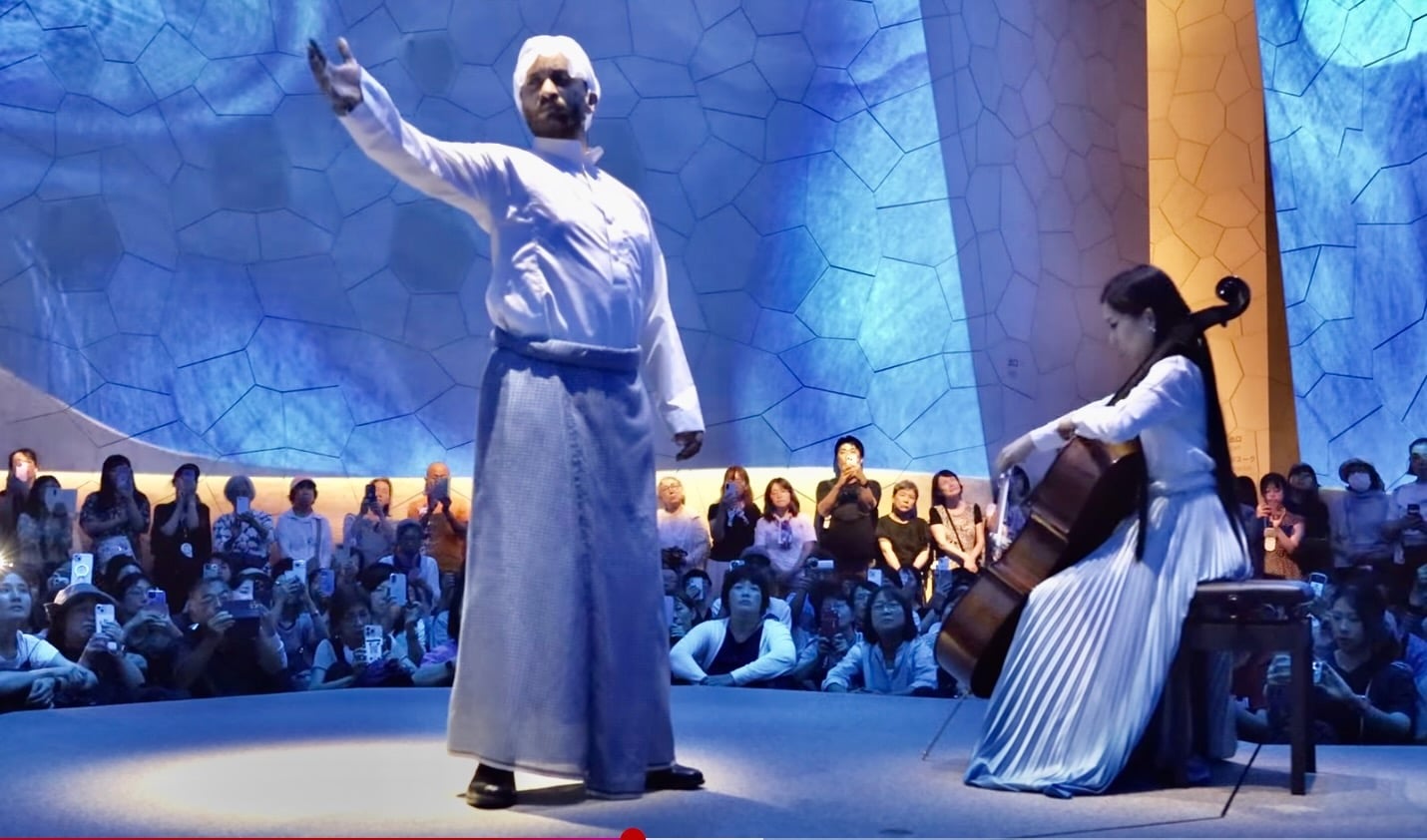
I wanted to learn more about this remarkable collaboration, so I went straight to the source: Manami Hirai’s Instagram. Hirai shared that she began rehearsals with Saleh on April 17th. At the time, she knew little about Saudi Arabian culture and felt a bit anxious, especially when she realized Saleh didn’t speak English. At first, they used body language, then developed a unique language using onomatopoeia, and eventually communicated through the universal language of music.
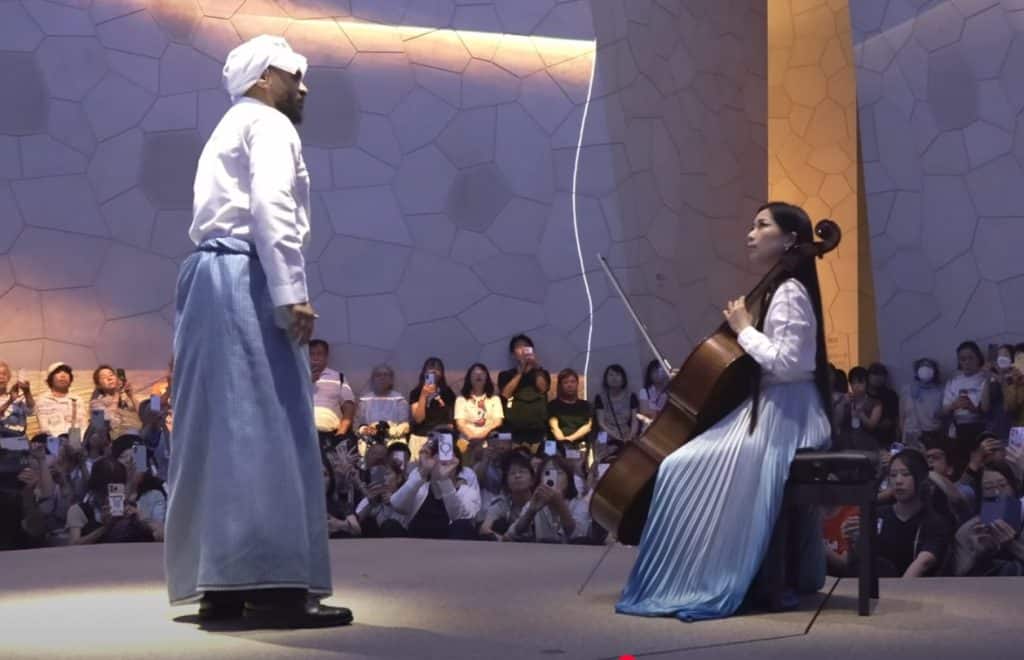
The shows with Manami Hirai and Saleh were originally meant to run from April 17th until June 15th, but the audience response was so great that it was extended twice, first until June 28th and then all the way to August 26th. I have a feeling we will be seeing these two great artists perform once again, possibly at the World Expo in Saudi Arabia in 2030. In the meantime, I hope that an official live performance of Tales of Water is officially released at some point.
Trying Saudi Coffee and Sweets
After the exhilerating performance we stuck around to try Saudi coffee and some sweets. I was expected the coffee to be dark with a bitter flavor, but it was actually golden-brown and more watery than Western-style coffee. It contains cardamom, which gives it a unique sweet-spicy taste. Saudi Coffee is meant to be sipped and slowly savored. It is usually served without milk or sugar, and offered to guests as a gesture of hospitality. The coffee came with a date. I also bought a small cake to go with it.
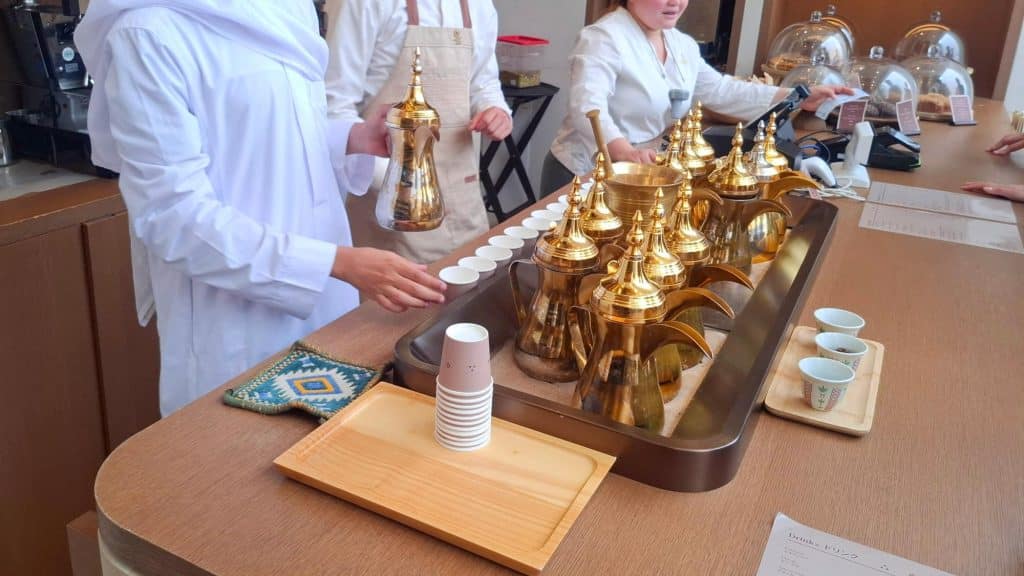
The Saudi Pavilion also has a restaurant on the premises called Irth. The food looks fantastic and is reasonably priced. I’m still kicking myself for eating a dish I could have gotten anywhere in Japan at the food court earlier when there was all this wonderful and rare cuisine to choose from. Live and learn!
Heading Home
We decided to end our visit to Expo 2025 on a high note. Since our phones had died, it turned out to be a bit of a problem because the tickets to board the shuttle bus were digital. However, after explaining our situation a helpful staff member let us on the bus. I know people who have been to Expo 2025 several times because they can’t get enough of it. For me, once was a enough and I’m glad I got to experience it.





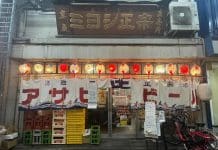





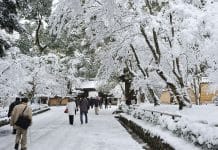








The author provides a captivating, immersive account of their journey through Expo 2025, vividly bringing each pavilion to life with detailed descriptions and personal reflections. The enthusiasm and curiosity shine through, making it easy to feel like a part of the experience.